The Hisense E8Q is a television that clearly draws heavily from the U7Q model – and very well so. After all, it is his European version, not another "slimmed down" mutation. Just moments with this screen reveal that the E8Q is putting up a fight. And in many respects, it really succeeds. To start with – what impresses: the blacks are deep, the contrast is high, and the brightness exceeds a level we can simply call satisfactory. Add to this almost perfect fluidity of tonal transitions and we have an image that looks very mature, especially for this price segment. In gaming? Just as good. Support for VRR, ALLM, 144 Hz in 4K and even 240 Hz in Full HD – it's hard to nitpick here. Well… almost. Because the E8Q has one additional flaw compared to the U7Q – sound. In our unit, even at moderate volume levels, the back of the casing began to resonate, generating rather unpleasant crackles. This could be a fault of the test unit, but since the U7Q simply performed better – it’s worth noting. Especially if you find both models at a similar price. We can confidently say that the E8Q is a television that can boldly compete for the attention of those seeking a quality Mini-LED at reasonable prices. If a good price opportunity arises, it is simply worth it – because we get almost the same as in the U7Q. And that means a really solid picture, great gaming features, and overall a very good piece of equipment that one can stick with for a longer time.
- Matching (Score)
- Our verdict
- TV appearance
- Where to buy
- Contrast and black detail
- HDR effect quality
- Factory color reproduction
- Color reproduction after calibration
- Smoothness of tonal transitions
- Image scaling and smoothness of tonal transitions
- Blur and motion smoothness
- Console compatibility and gaming features
- Input lag
- Compatibility with PC
- Viewing angles
- TV efficiency during daytime
- Details about the matrix
- TV features
- Apps
- Playing files from USB
- Sound
Hisense E8Q vs Samsung Q7F
Direct compare
E8Q
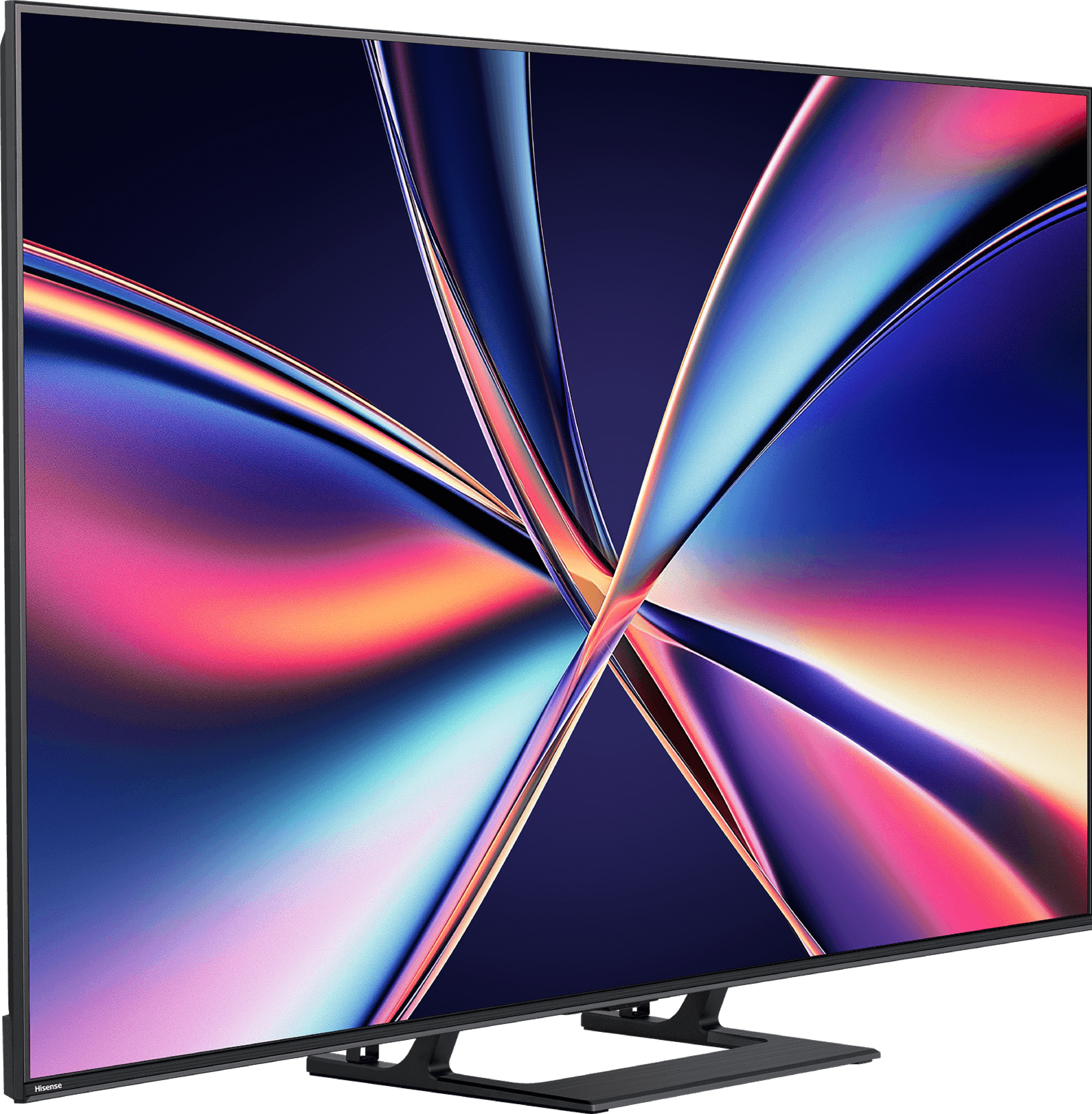

Panel type: LCD VA
Resolution: 3840x2160
System: VIDAA
Model year: 2025
Complete the survey to find out the result

Panel type: LCD VA
Resolution: 3840x2160
System: Tizen
Model year: 2025
Complete the survey to find out the result

Overall rating
7.2
5.7
Movies and series in UHD quality
6.7
5.7
Classic TV, YouTube
6.8
5.6
Sports broadcasts (TV and apps)
6.5
5.3
Gaming on console
8.0
6.3
TV as a computer monitor
8.6
6.0
Watching in bright light
6.2
3.9
Utility functions
8.9
6.6
Apps
7.7
8.7
Sound quality
7.2
5.8
Complete the survey to find out what fits your preferences
Advantages
Great contrast and deep blacks
Very good fluidity of tonal transitions (close to reference level)
High brightness
Support for 4K 144 Hz and even 240 Hz in Full HD
VRR, ALLM, G-SYNC – a complete package for gamers
Low input lag
Many classic television features integrated into the VIDAA system
Solid native contrast (VA Panel)
Vivid colours thanks to QLED filter
Low input lag (around 10ms)
Advanced and smooth Tizen operating system
Compact sleek design with Type-C charging
Disadvantages
No support for HGiG (makes setting up HDR on consoles difficult)
Poor viewing angles – typical for VA panels
Closed VIDAA system – lacks some applications
Inferior sound quality compared to the twin model U7Q
Very low brightness (only 250 nits in HDR)
Lack of many features for gamers including VRR and HGiG – the manufacturer promised something, but in the end, those features are simply not available
Lack of many classic "television" features e.g. recording to USB or PIP
No Dolby Vision
Average quality of digital image processing
Our verdict
The Samsung Q7F is the manufacturer's cheapest model from the QLED line, and it must be admitted that a few advantages can easily be specified here. After calibration, the colours look really good, and the additional QLED filter makes the hues more saturated than in typical budget LCD televisions. Additionally, it features a VA panel that offers quite decent native contrast. It is certainly not at the level of top-tier models, but it performs adequately for everyday viewing. However, the biggest plus is the Tizen system, which is Samsung's flagship offering. It operates smoothly, is feature-rich, provides access to a multitude of applications and add-ons, and at the same time allows for straightforward connection of the television to the SmartThings ecosystem and control of other devices in the home. And basically, this is where the list of advantages ends, as the longer you use the Q7F, the more apparent it becomes that this is a product that is significantly underdeveloped. It's not just about the panel itself with its low brightness and mediocre picture quality in HDR films, but also about the lack of features that typically worked flawlessly in Samsung models. The manufacturer claims the presence of VRR and HGiG, but in practice, they offer no benefit, making it difficult to recommend this television even to casual gamers. It also does not perform particularly well for regular television as the digital image processing is at best average, and the tone transition enhancement feature, which usually worked excellently in Samsung models, hardly functions here. The Q7F is a piece of equipment that can only be recommended to those looking for a television with two phrases on the box: “QLED” and “good Smart TV”. Everyone else receives a rather bland product that falls significantly short of competing even with other more budget-friendly options. It’s a pity because usually, the word "QLED" in Samsung meant something more than just an ordinary television.
TV appearance
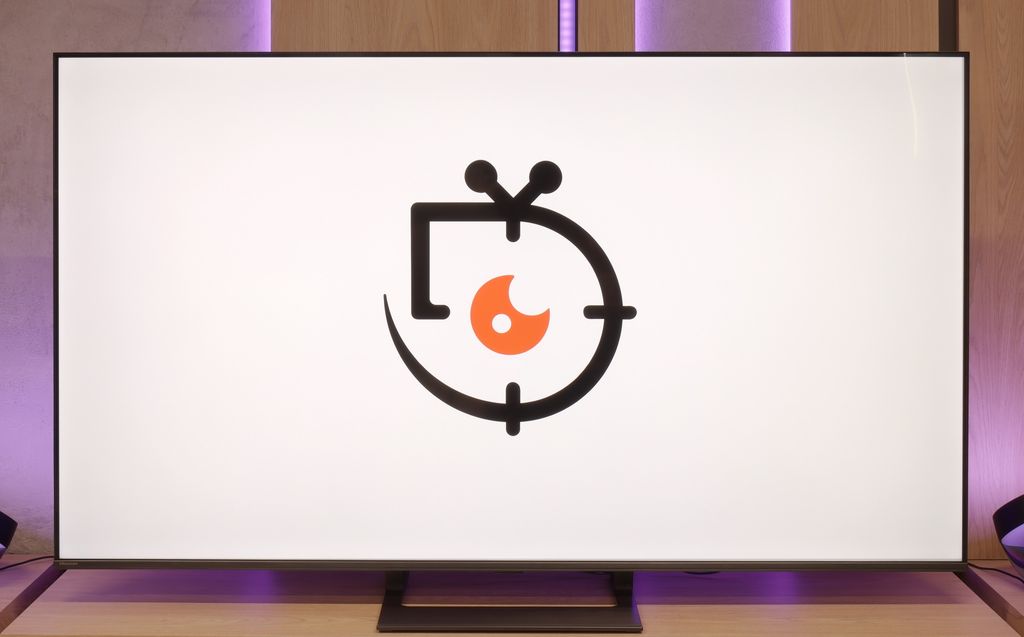
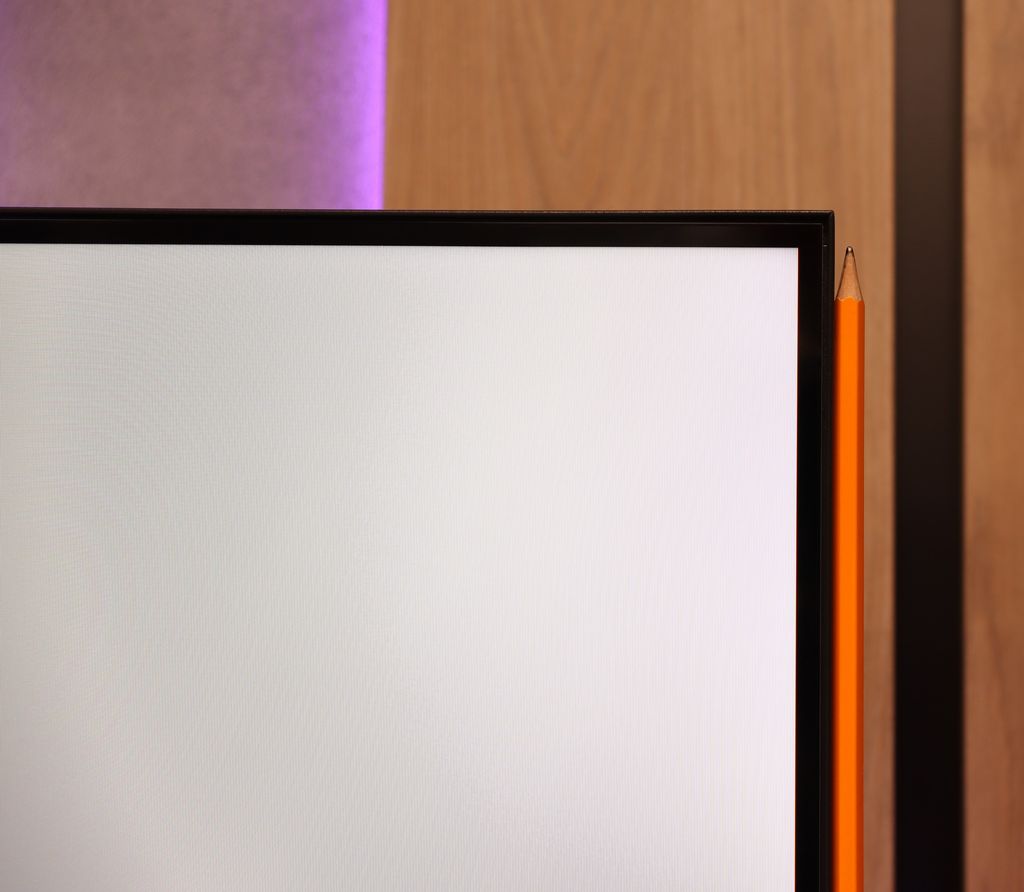
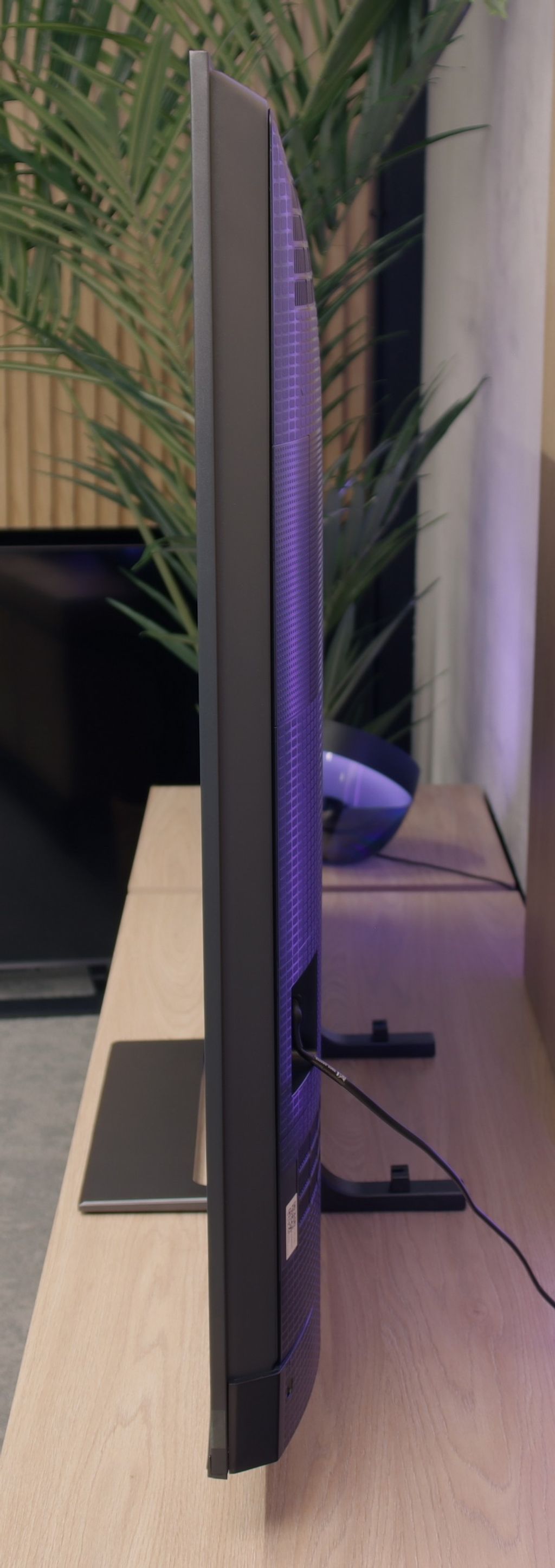
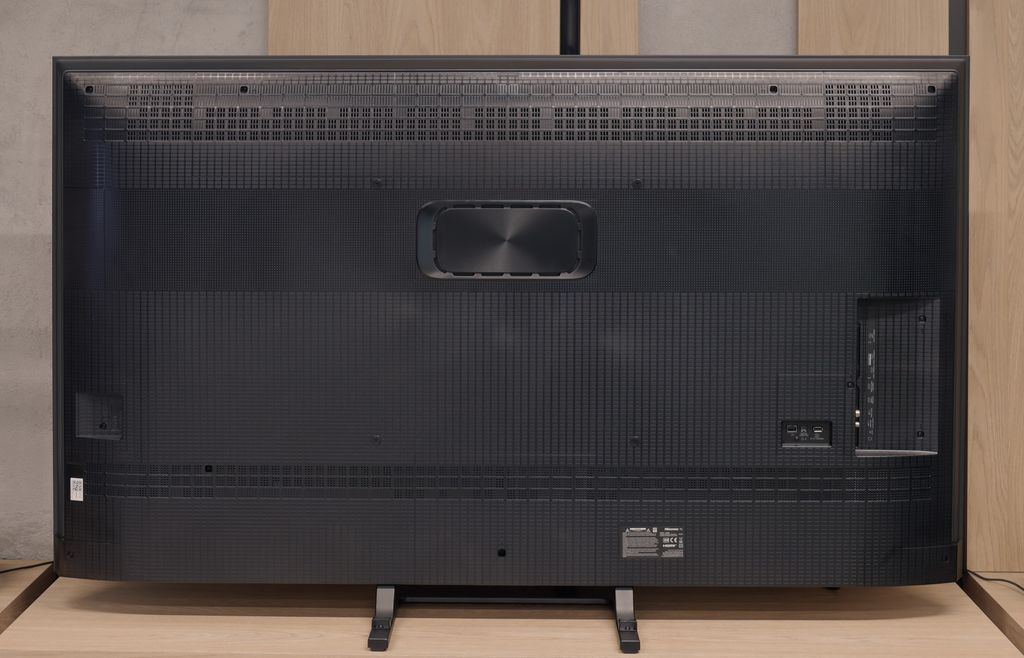




Contrast and black detail
7.6/10
4.7/10
Local dimming function: Yes, number of zones: 220 (10 x 22)
Local dimming function: No
Contrast:

Result
277,000:1

Result
43,700:1

Result
15,750:1

Result
8,850:1

Result
6,350:1

Result
2,850:1

Result
2,750:1

Result
3,300:1

Result
3,050:1

Result
2,750:1
Halo effect and black detail visibility:
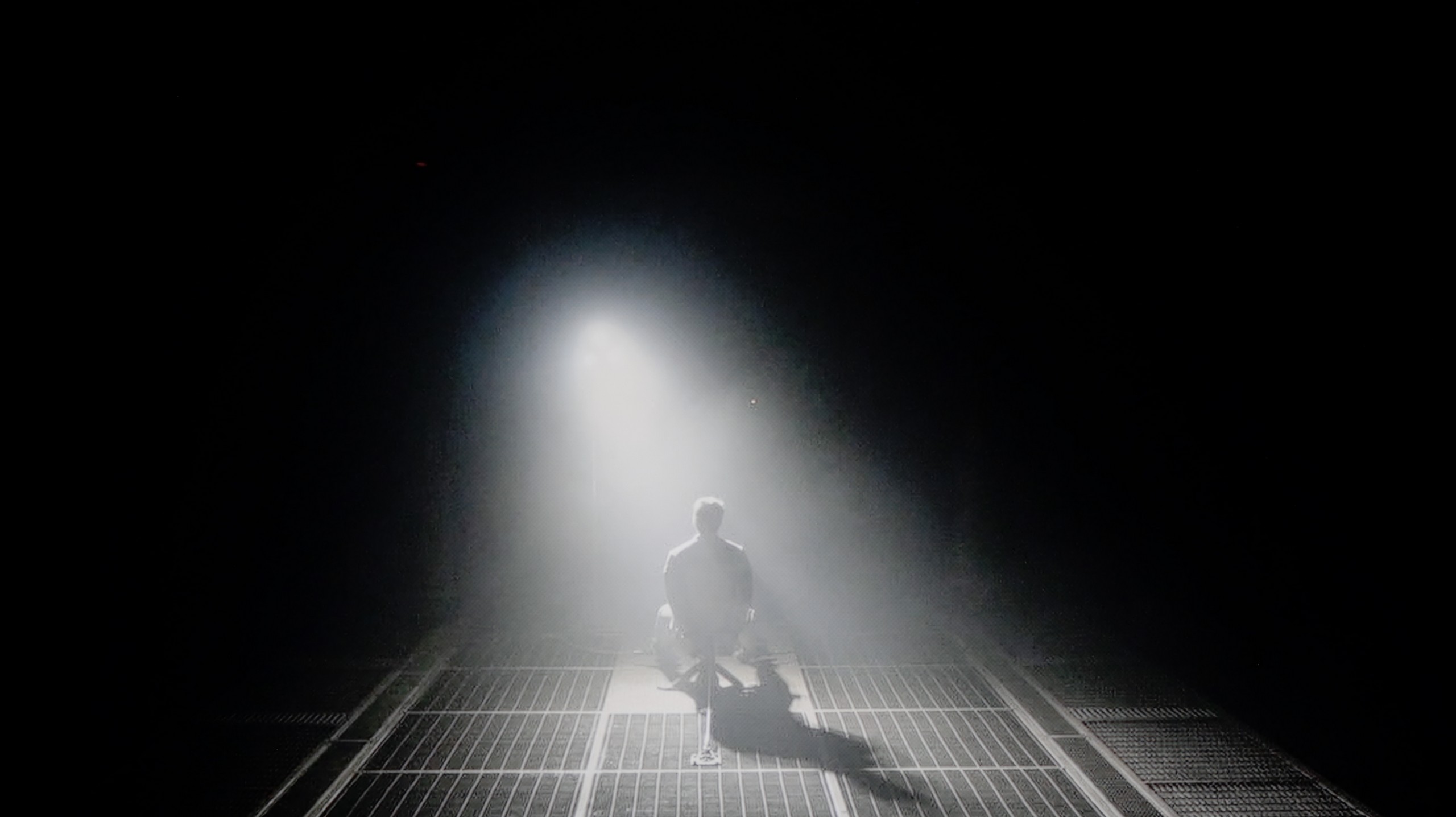

Similar to the U7Q, the E8Q model uses a VA panel and Mini-LED backlighting. The number of dimming zones also remains at a very similar level – in the 65-inch variant we tested, we counted 220 zones, which is exactly the same as in the U7Q. On paper, this looks really good for this price segment, but even better – in practice. The contrast is high, and the black can be really deep. In many scenes, the lights are clearly separated, and the image gains a sense of depth. This is one of those cases where Mini-LED shows that it can approach the quality of OLEDs – of course, assuming that we understand the limitations we have to contend with. In very challenging scenes, there may be slight brightenings or a small halo effect around bright objects, but these phenomena are typical of this technology and do not stand out strongly. Ultimately – the contrast and blacks in the E8Q are really solid, almost identical to those in the U7Q model. It’s hard to find anything to criticise here, especially when we consider the price of the television.
The Samsung Q7F in the tested size of 55 inches has a VA panel, which immediately translates to decent native contrast. Values around 3000:1 may not be record-breaking, as we know that panels with more than double the contrast are currently being produced, but it still performs much better than IPS or ADS panels, where black quickly fades into shades of grey or navy blue. Unfortunately, we do not find typical local dimming zones here, but the manufacturer has included something akin to global dimming – that is, dimming the entire screen in relation to the content. The effect? In most scenes, black appears rather solid, although during night viewing sessions, we will still see that it more closely resembles dark navy or grey than true pitch black. Overall, it's okay, but without fireworks – it's not spectacular, but it's also not a disaster.
HDR effect quality
4.5/10
3.7/10
Luminance measurements in HDR:

Result
531 nit

Result
148 nit

Result
320 nit

Result
100 nit

Result
625 nit

Result
215 nit

Result
225 nit

Result
267 nit

Result
113 nit

Result
250 nit
Scene from the movie “Pan” (about 2800 nits)


Scene from the movie “Billy Lynn” (about 1100 nits)
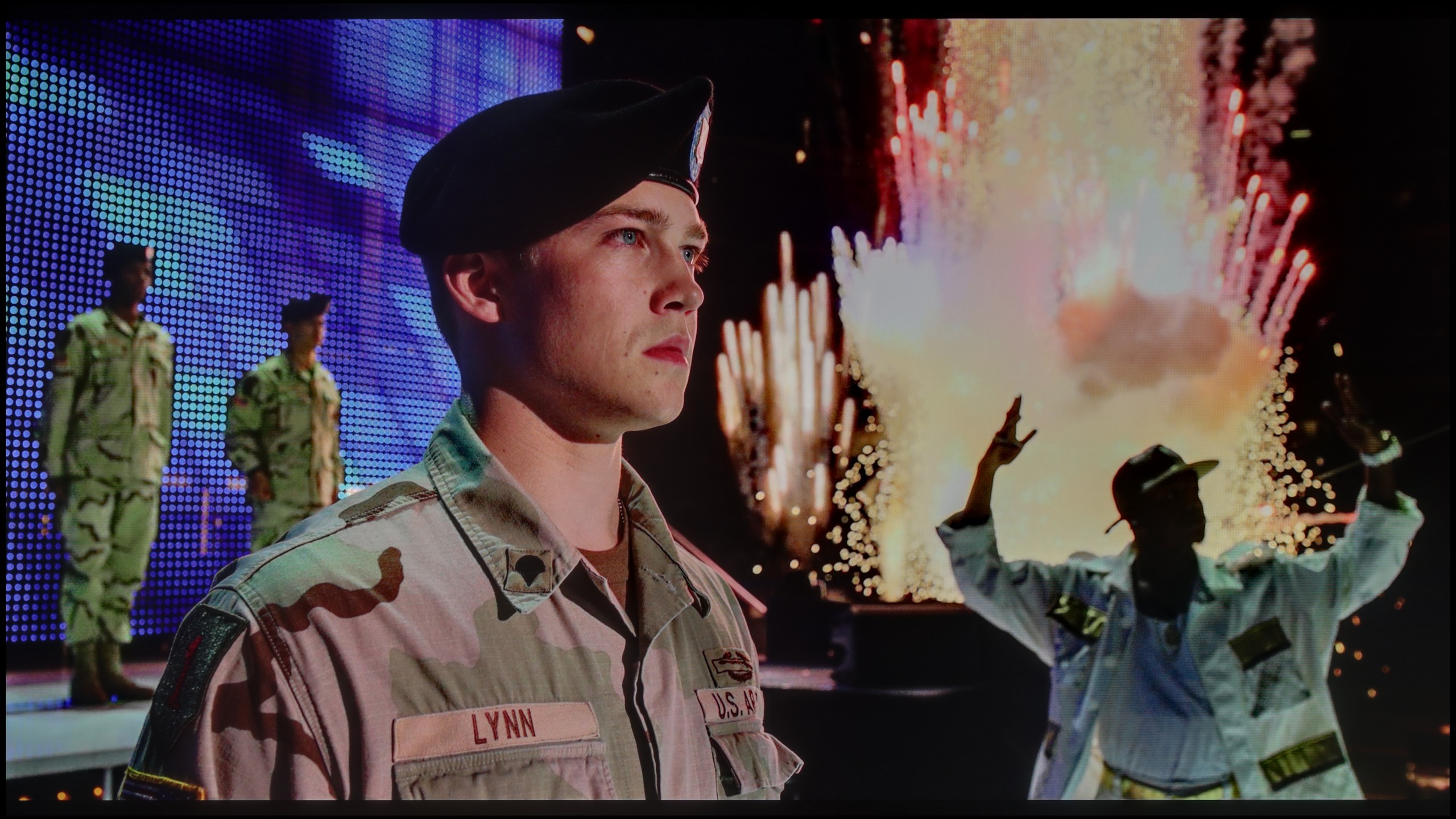

Static HDR10


Dynamic: Dolby Vision
Dynamic: HDR10+


HDR luminance chart:
Samsung Q7F
HDR luminance
Hisense E8Q
HDR luminance
Since the E8Q is a twin of the U7Q, it’s no surprise that the quality of the HDR effect is nearly identical. On paper, it looks promising – a peak brightness of 800 nits can impress in many scenes. Moments such as flashes of light in “The Meg” or shots of the sun in “Life of Pi” can indeed evoke a 'wow' effect. But the longer we watch, the more we notice the limitations. The problem arises when small, bright details need to be shown against a dark background. In such situations, the dimming algorithms try to preserve contrast but end up dimming what should shine the most. Instead of dazzling details, we get almost invisible points of light. This is typical for Mini-LEDs in this price segment and is not surprising – but it’s worth knowing that the HDR effect will not always be fully preserved. Fortunately, the colour performance offers reasons to be pleased. Coverage of the DCI-P3 colour gamut at around 94% is a very good result, and the applied layer of quantum dots (more precisely, PFS) does its job – the colours are saturated and vibrant, especially with 4K content.
Unfortunately, the Samsung Q7F is not one of the brighter televisions, and this has a direct impact on the quality of HDR films. The peak brightness of the panel is just around 250 nits, which is definitely too low to speak of true cinematic experiences. In practice, the image in HDR content does not differ significantly from classic SDR, making it difficult to talk about any "wow effect" that usually accompanies us when watching such films. During tests of film scenes, the image simply looked dark, and the brightness almost always hovered around the aforementioned 250 nits. The worst performances were with shots that included small, intensely shining elements – the global dimming technique used reacted very aggressively in these cases, dimming the entire screen to maintain the effect of black. However, it is worth noting the presence of the QLED coating that expands the colour palette. For a budget QLED model, the Q7F performs quite decently here: the coverage of the DCI-P3 palette is about 93%, and BT.2020 reaches 70%. This means that, despite the low brightness, the colours can still look quite vivid and attractive.
Factory color reproduction
6.5/10
5/10
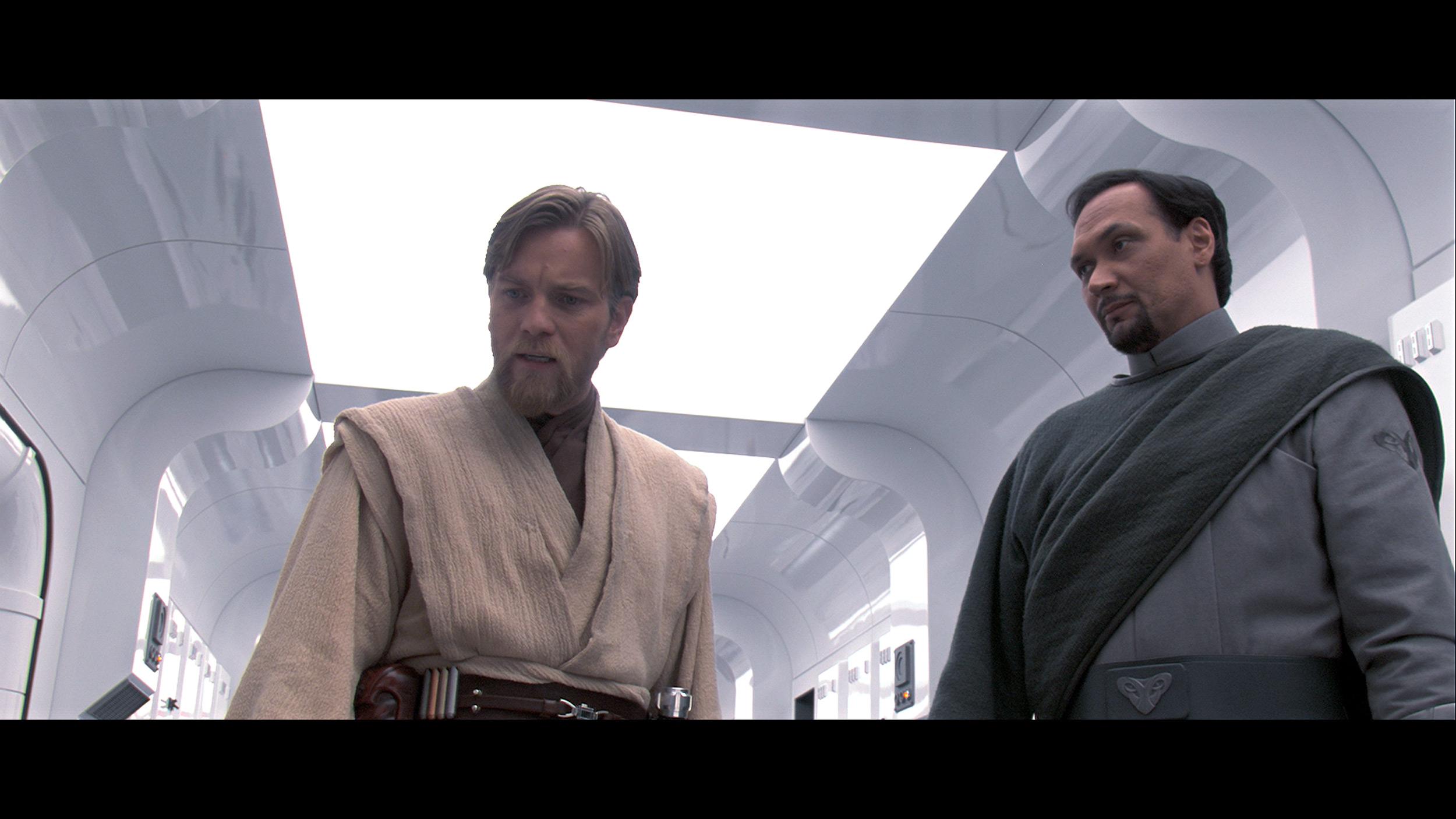
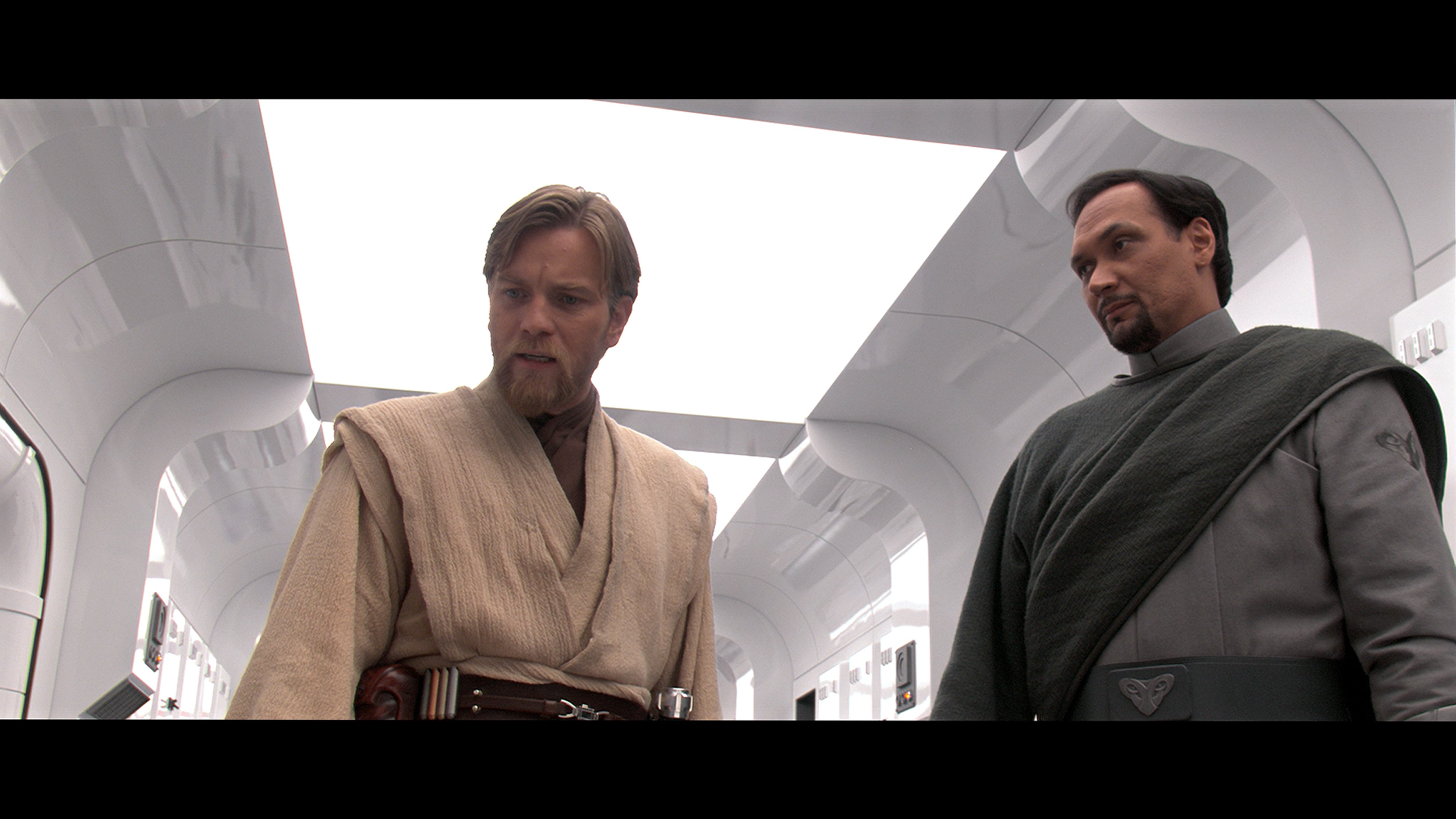
Factory Mode
After calibration


Factory Mode
After calibration
Testing the Hisense E8Q in Filmmaker mode, we were hoping for a possibly neutral image close to the director's vision. Unfortunately – although it doesn't look bad on paper (the colour reproduction errors are not significant), in practice the image appears not entirely natural. The reason? An overly strong boost in blue colour and a lack of red in the white balance. The effect? Scenes look cool, and the white seems slightly bluish. Alongside the U7Q model, we also noticed a specific approach to brightness management here. The brightness mapping curve for HDR content (EOTF) shows that the television can significantly dim small, bright elements on the screen to maintain contrast – but sometimes it goes too far in this. On the other hand, larger, very bright areas can be excessively brightened, which disrupts tonal balance. This is a compromise that may not suit everyone – especially if you want an as faithful image as possible right out of the box.
The factory colour accuracy of the Samsung Q7F is certainly not one of its strong points. In Filmmaker mode, which theoretically should be the closest to neutral, the issue with white balance immediately stands out. There is too much red on the screen, while blue is lacking. The consequences of this are very easy to notice – white, instead of being neutral, takes on warm, almost slightly orange tones. In the long run, this makes the entire image look somewhat unnatural, and bright areas of the scene may seem unrealistic. The problems become even more evident in HDR content. The graphs show that the television has significant errors in the Color Checker palette, which translates to visible inaccuracies in the actual image. Practically, this means that the colours are not presented as they should be. The Q7F also heavily manipulates brightness; darker elements are overly boosted, losing their cinematic quality, while bright parts may appear dimmed. As a result, the image seems flattened, and contrast, instead of helping to bring out details, only highlights its own limitations. This is particularly frustrating in HDR material, where every detail matters. In scenes where there should be a subtle play of light and shadow, the Q7F either oversteps by brightening too much or conversely – suppresses elements that should draw the eye. This causes the image to lose its depth, and instead of cinematic realism, we have a rather simplified effect.
Color reproduction after calibration
7.4/10
7.6/10
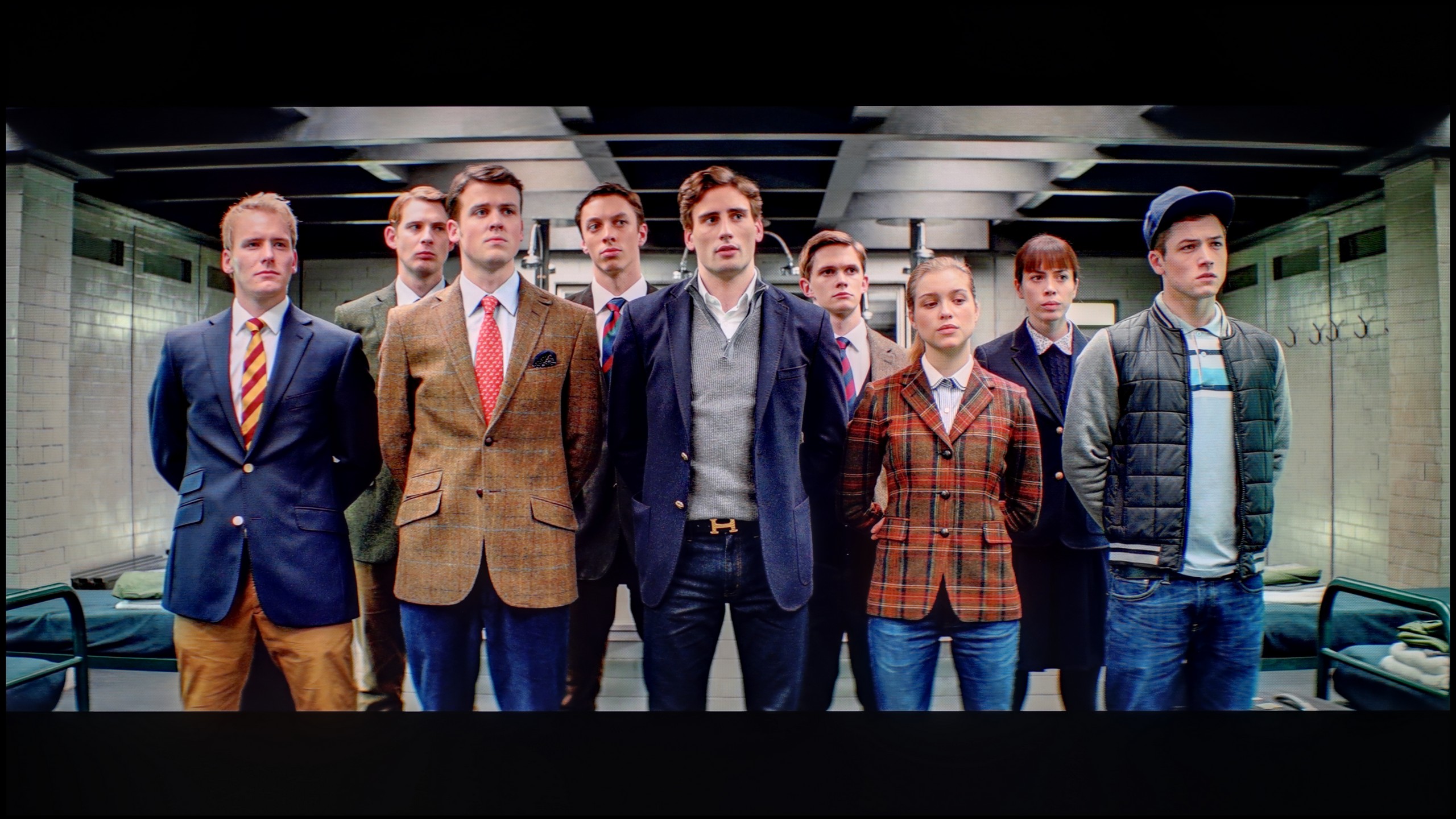



The calibration of the Movie mode yielded really good results, especially when it comes to SDR content. We managed to balance the white levels, which made the image look more natural – it appeared almost reference-quality. The colours were well-saturated, and the overall perception of the content improved significantly. Unfortunately, when we switched to HDR materials, familiar issues from the U7Q model returned. The television still likes to "do its own thing," as evident from the analysis of the brightness characteristic EOTF – despite calibration, the E8Q still dimmed fine details in the shadows, while the bright areas of the screen could be excessively boosted. In practice, this means that in darker scenes, some of the smallest details could simply disappear. Although it must be acknowledged that the entire calibration process brought a lot of good, not everything can be circumvented – even with the use of professional tools. The E8Q can impress with its picture, but in HDR content, its design limitations become apparent, and it is worth keeping this in mind.
After professional calibration, we managed to bring the Q7F into order – at least in terms of SDR content. The picture in this mode looks really good: the white balance has been set correctly, the colours appear natural, and errors in the colour palette have dropped to levels that are practically invisible to the eye. Gamma behaves exemplary, and the only minor drawback is a slight lightening of smaller elements, which results from the lack of local dimming. For everyday watching of television or films in standard quality, the Q7F performs surprisingly well.
It was significantly harder to tame HDR content. Despite adjusting the white balance, the television still heavily manipulates brightness, causing scenes to sometimes look unnatural – what should be subtly darker can be overly brightened, and bright areas of the picture can occasionally appear dimmed. The end result is better than in factory settings, but it is evident that the structural limitations of the Q7F do not allow for the full potential of HDR materials to be fully realised.
Smoothness of tonal transitions
9.9/10
9/10
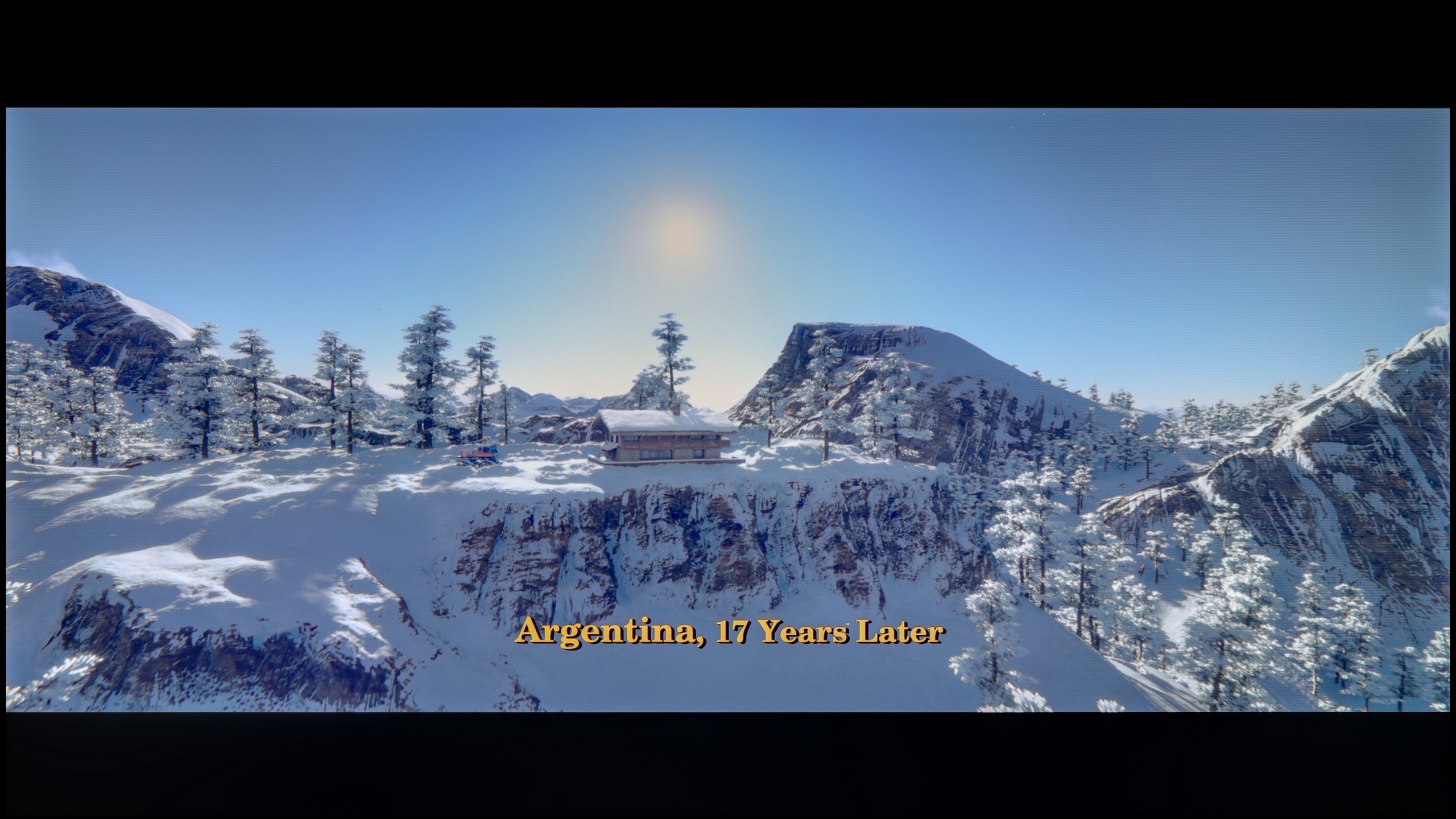



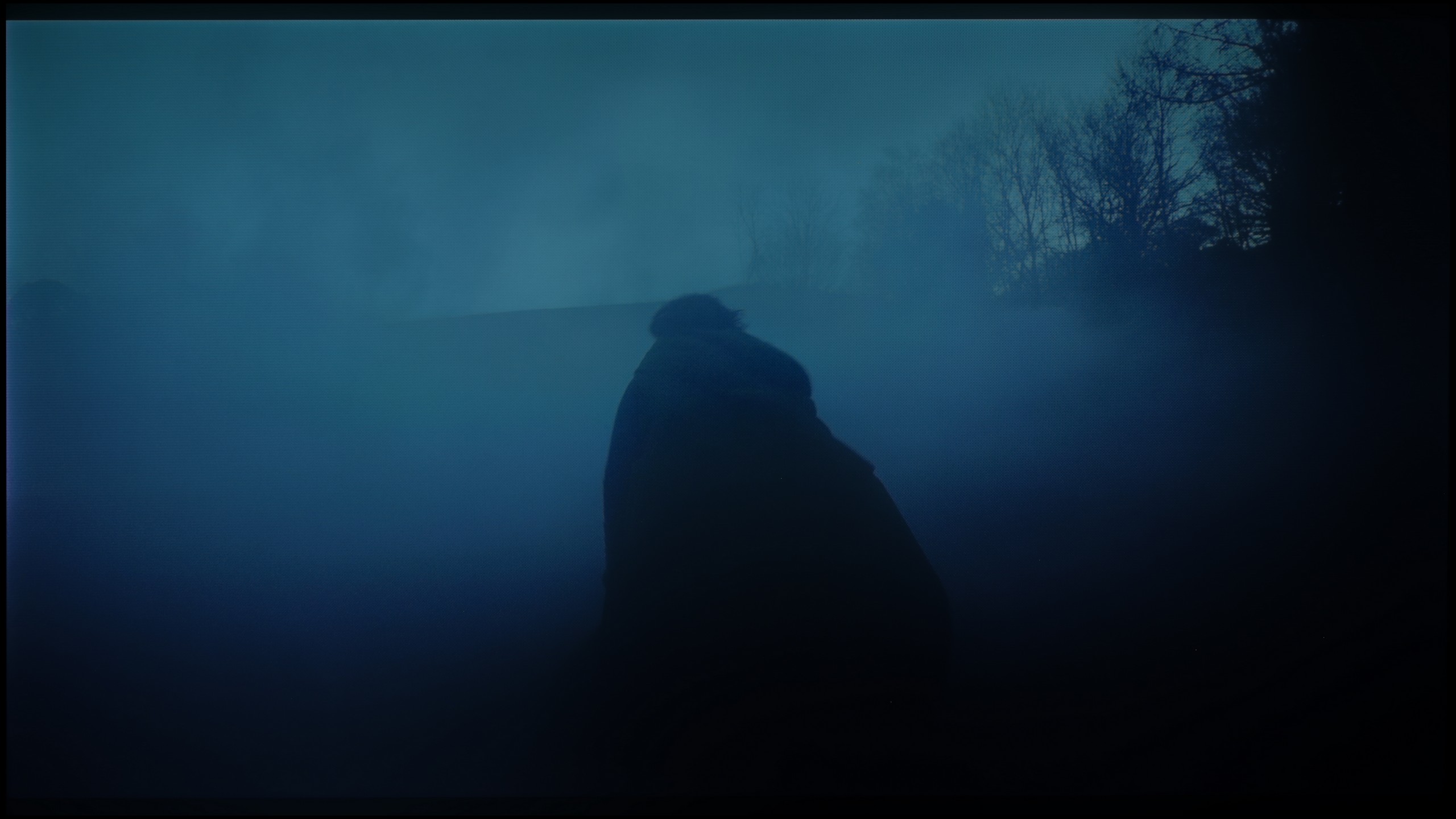

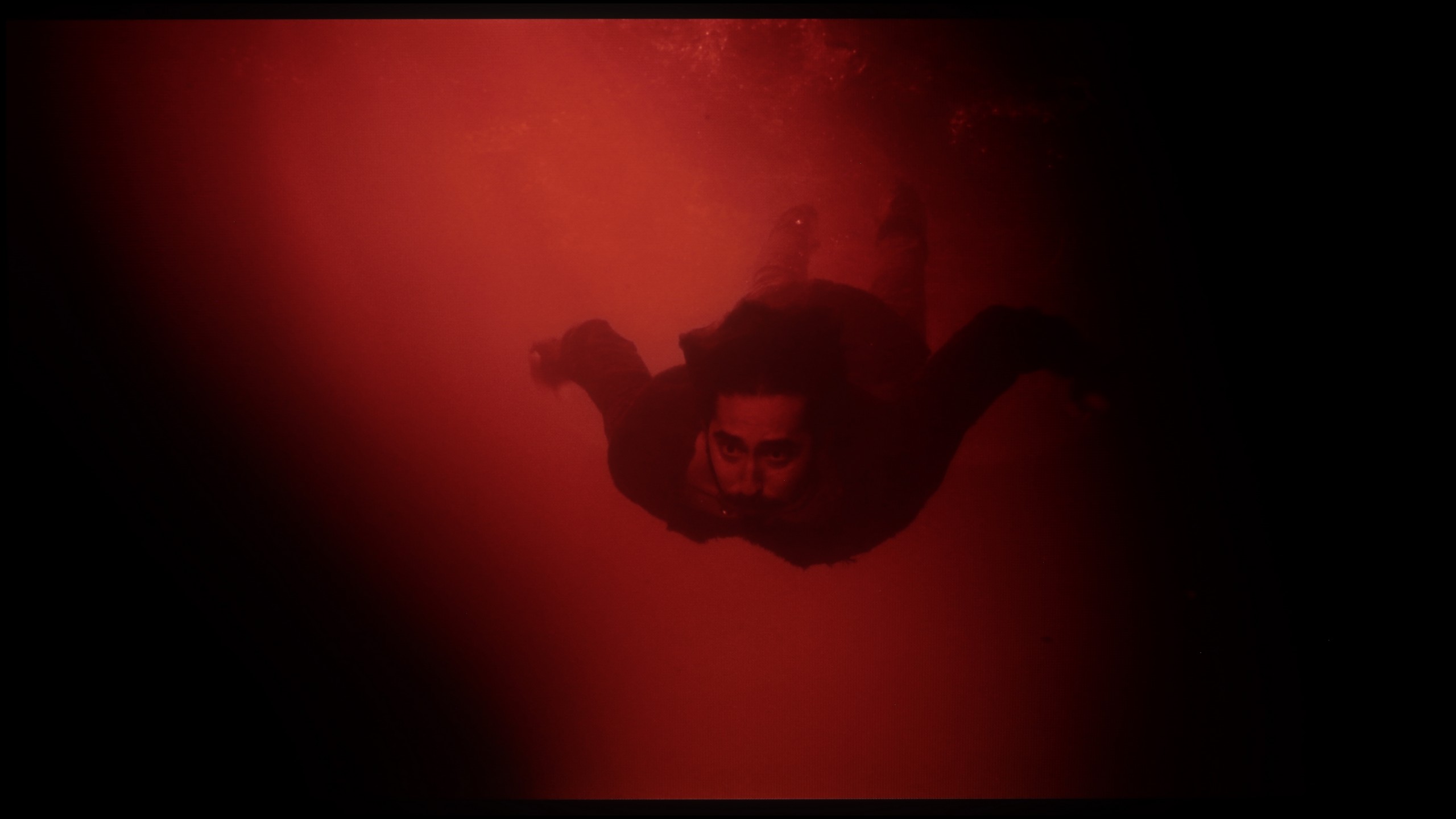





In this category, the Hisense E8Q really demonstrates class. The transitions between colours are very smooth, with no 'banding' or clear boundaries between tones. The image looks natural, and the colour gradation is exceptionally good – even in more difficult scenes. If there are any minor imperfections, they are subtle enough not to be noticeable. It's hard to nitpick here – it looks almost flawless.
The fluidity of tonal transitions in the Q7F is really quite good. The gradients are smooth, without strong stair-stepping or artificial divisions that can be quite noticeable in cheaper televisions. Even in more challenging scenes, such as the one from The Revenant or the red shot with the actor swimming in water, the image maintained quality and simply looked good. If someone were to look very closely, they might notice slight imperfections in extremely demanding moments, but they are subtle enough that most people won't even notice them. For this price range, the Q7F performs surprisingly solidly in terms of gradation, and it's hard to find anything significant to criticise.
Image scaling and smoothness of tonal transitions
6/10
4.5/10
Smooth transition function
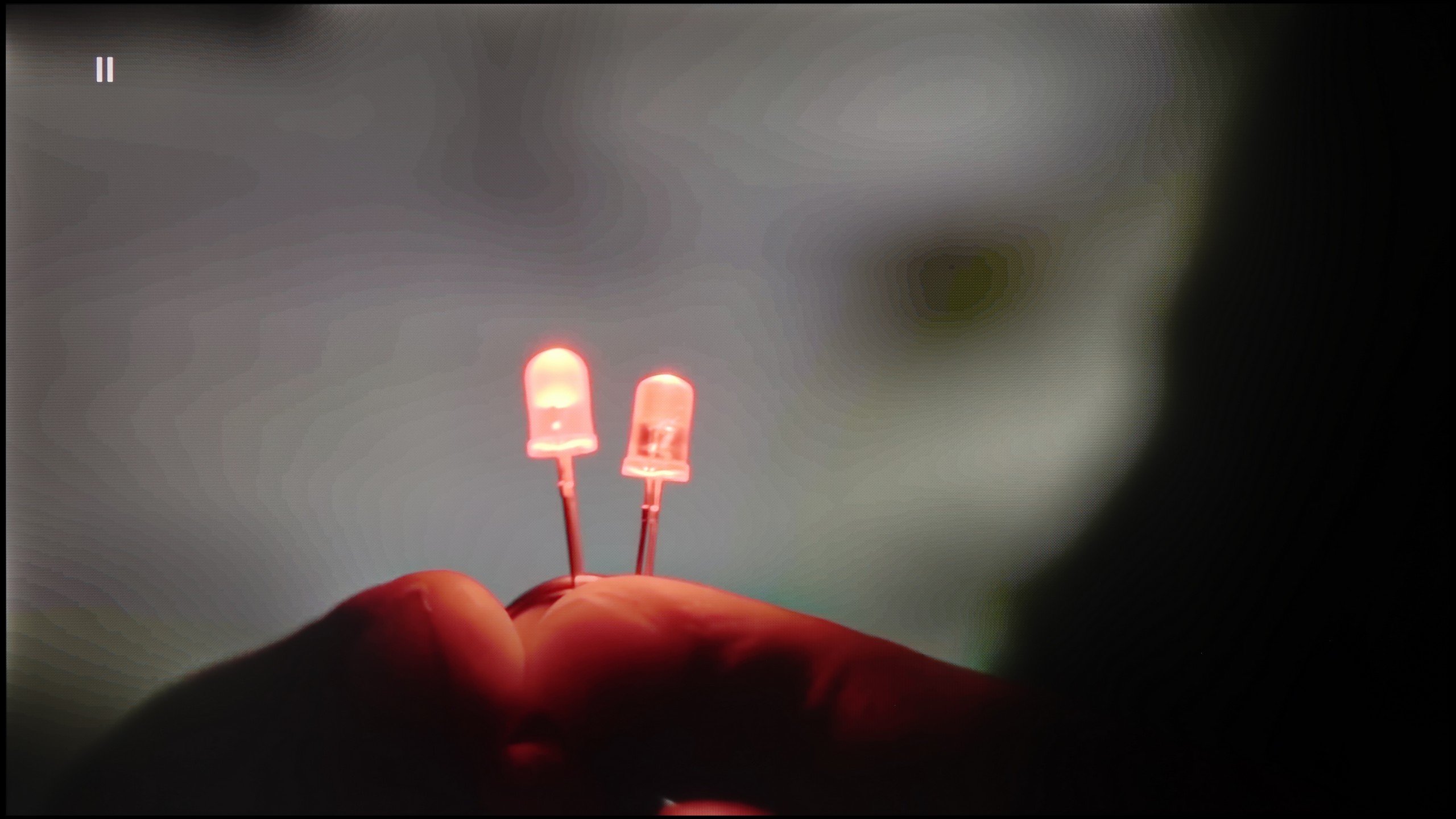

Image without overscan on the SD signal


In the case of older materials with lower quality, a gentle smoothing of tonal transitions often comes in handy. The Hisense E8Q, like the U7Q, features an "Smoothing and Gradient Image" function, but unfortunately – its effectiveness leaves much to be desired. The "Low" mode is almost imperceptible in operation, and the higher settings do not improve transitions but simply blur the details. The good news is that the function does not compromise film grain, meaning it does not worsen the structure of the image. On the plus side, scaling is commendable. The television is able to sensibly upscale older content to a higher resolution – without artificially accentuating contours or excessive sharpening. Although it does not match the best models in this category, it performs quite well for its class.
Upscaling and digital image processing on the Q7F is a bit of a sine wave. On one hand, we have really nice upscaling – weaker sources look better than one might expect. The image becomes clearer, sharper, and even older films or terrestrial television perform adequately. Samsung has been strong in this area for years, and the Q7F confirms that. On the other hand… there are some issues. The television has a problem with overscan – part of the image is simply cut off, and it doesn't look very elegant. Additionally, we were let down by a feature called "noise reduction", which should improve the smoothness of tonal transitions in weaker materials. In other Samsungs, it works relatively well, but here it makes practically no difference – the banding in gradients is still there. It's a bit of a shame, as one could have expected more from a model that is aimed at users looking for a display for SDR content.
Blur and motion smoothness
7.5/10
5.5/10


Blur (native resolution, maximum refresh rate):
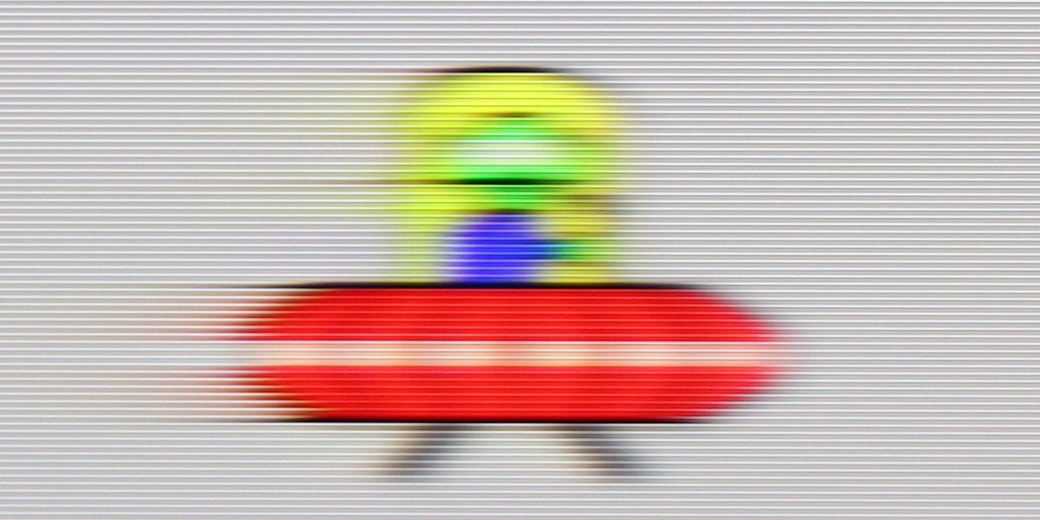
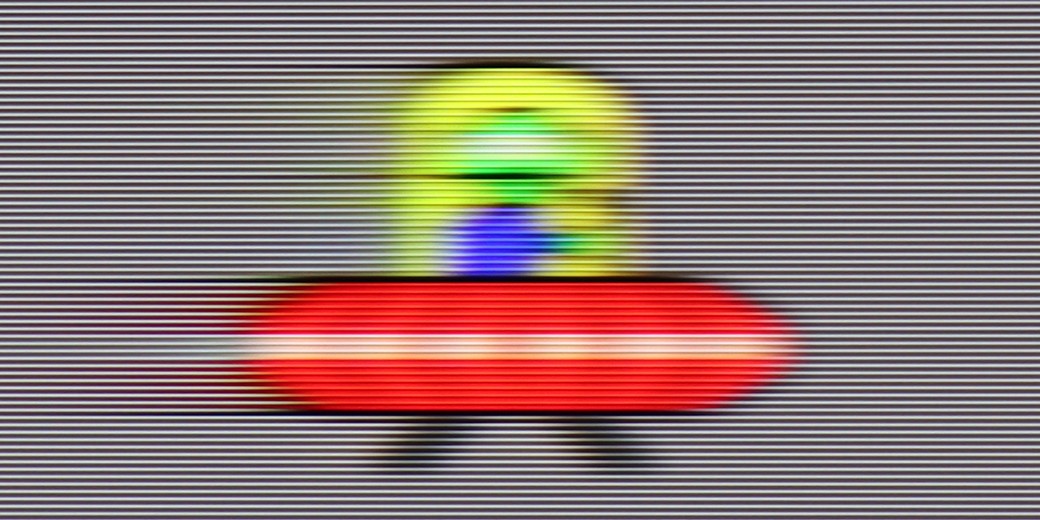
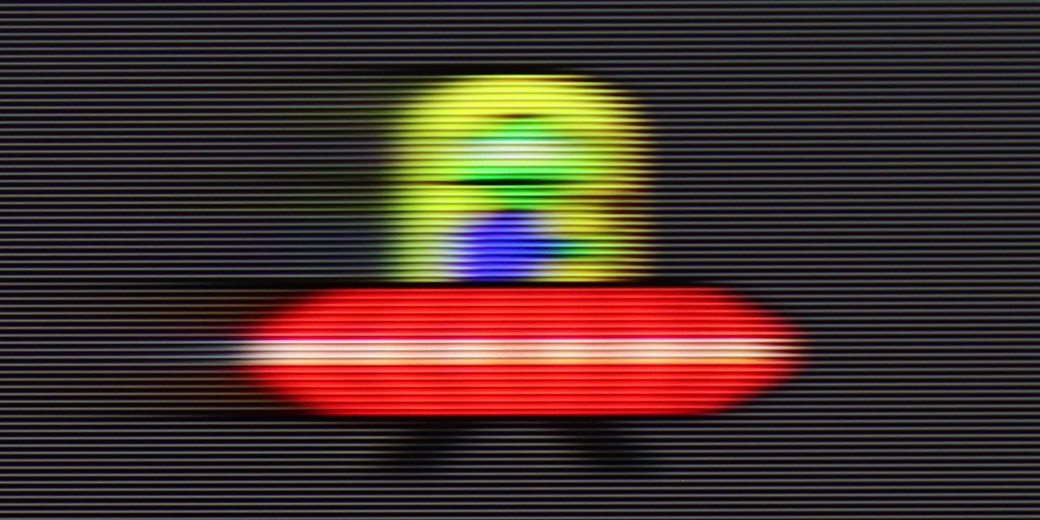



Blur (BFI function enabled):
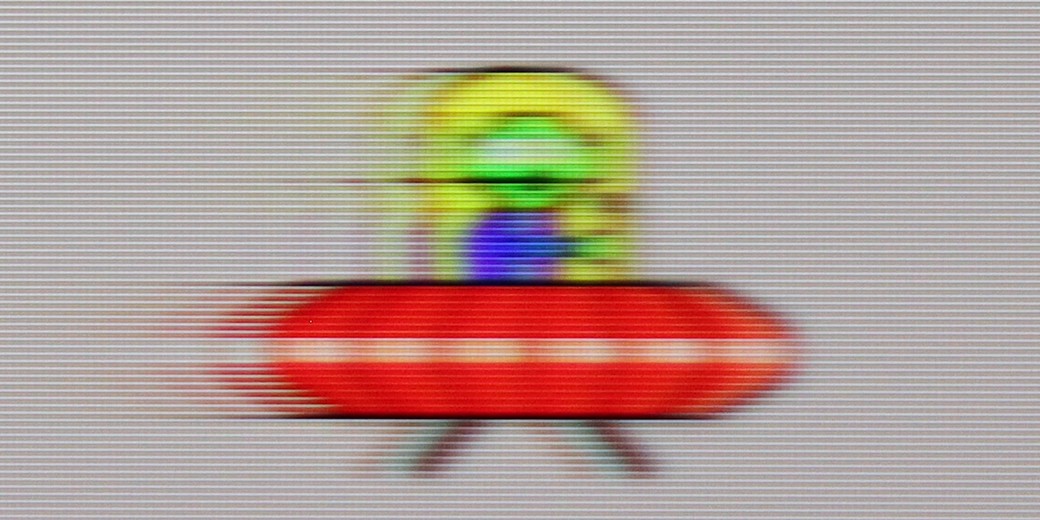

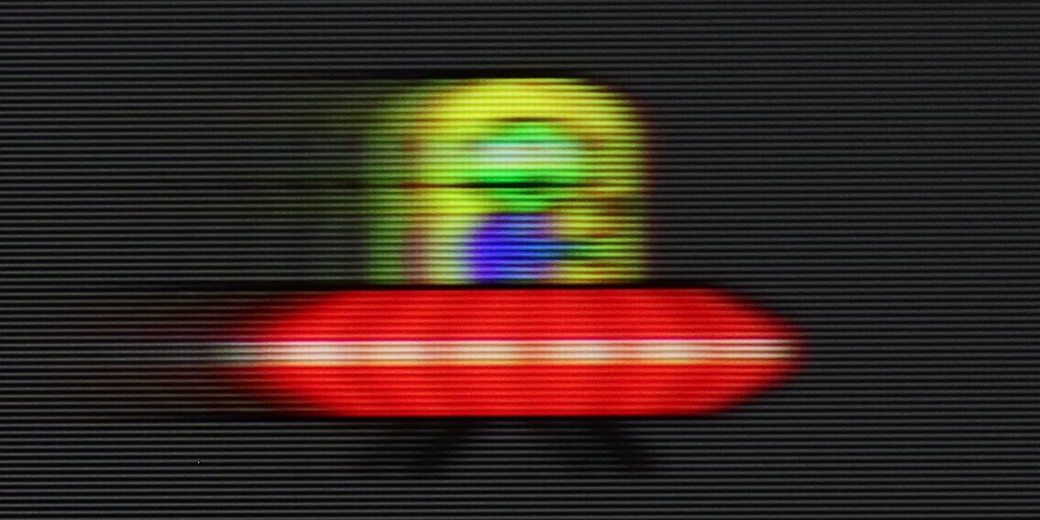
Image flickers in this mode



Smużenie (4K 120Hz):
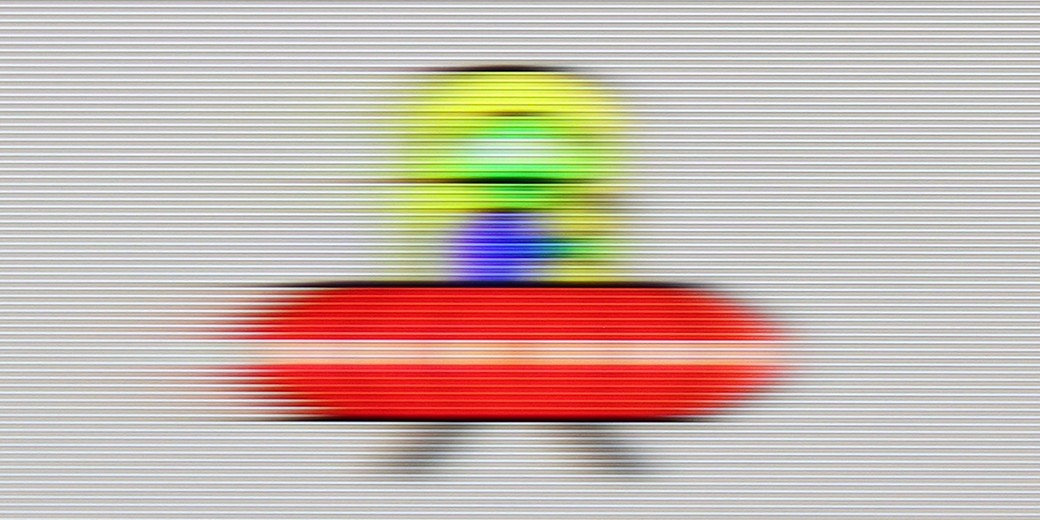
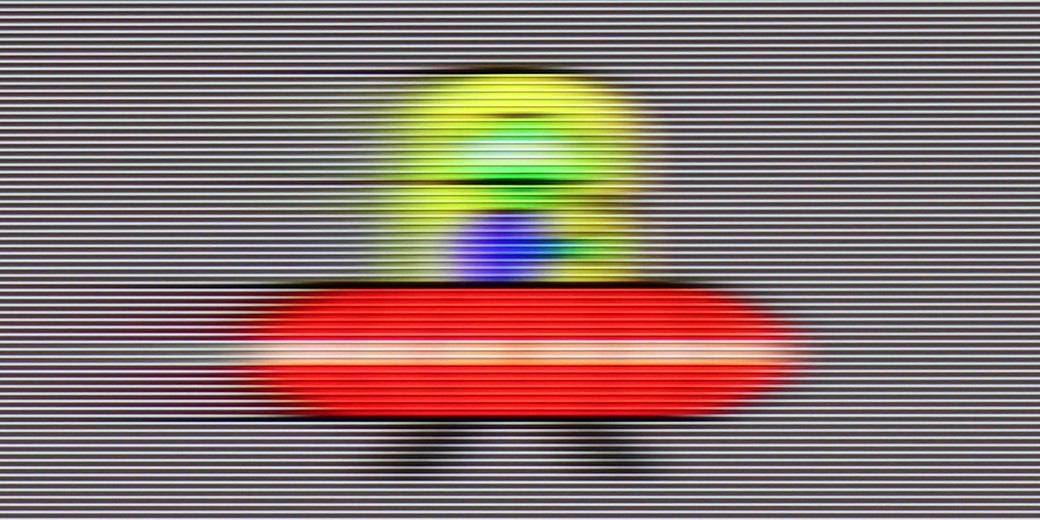
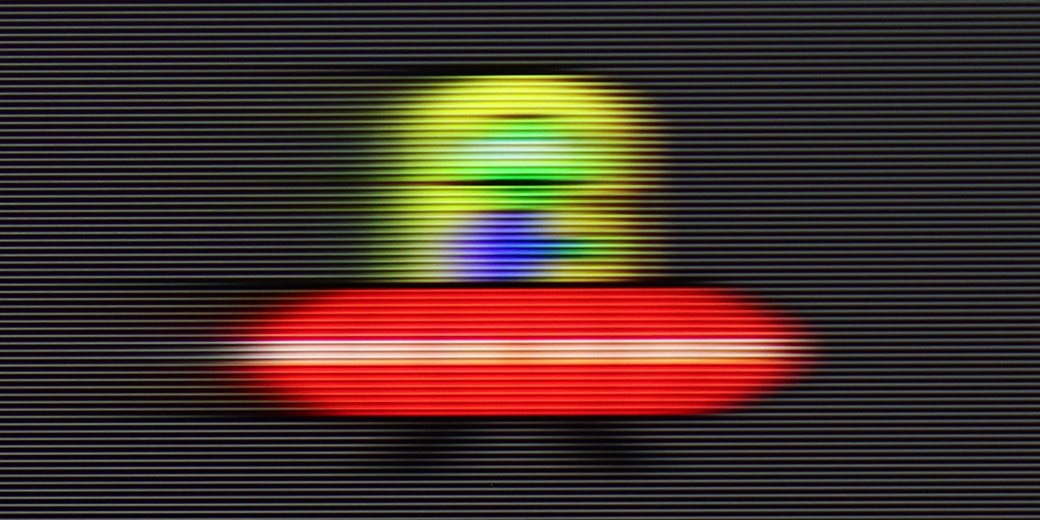
Smużenie ():
Similar to the U7Q, the E8Q model is a fast television designed for dynamic content. It supports a refresh rate of 144 Hz at 4K resolution, and if, for some reason, someone is still gaming in Full HD – it can even reach 240 Hz. This is a significant advantage, especially for PC users looking for maximum smoothness. In everyday use, the television performs very well. The "Ultra Motion Smoothness" mode offers two sliders that allow you to customise the picture to your preference – whether more cinematic with the film frame preserved or highly smoothed, almost "series-like". It's good that the manufacturer provides a choice here instead of imposing one style. On sports material, live broadcasts, or in games – movement looks clean and stable. Of course, it is not at the OLED level, but for this price range, the E8Q performs really well.
Ghosting and motion smoothness in the Q7F are probably the most budget-friendly elements of this television. The 60 Hz panel makes itself known, with noticeable ghosting, especially in dynamic scenes, and it's rather difficult to regard this model as equipment designed for watching sports or playing fast-paced games. In tests with the little green man, a long trail was left behind, similarly to how a ball in a football match would leave streaks.
On the plus side, the presence of motion smoothing must be acknowledged. In films, it actually makes a difference – especially since most material is recorded at 24 frames per second. Here we can decide whether we prefer a more "cinematic" image, with slight judder typical of cinema, or a smoother, more "television" approach. This part works quite well and helps to improve the viewing experience for series and films.
Console compatibility and gaming features
8.5/10
3.3/10
- ALLM
- VRR
- VRR range48 - 240Hz
- Dolby Vision Game Mode
- Correct implementation of HGIG
- 1080p@120Hz
- 1440p@120Hz
- 4K@120Hz
- Game bar
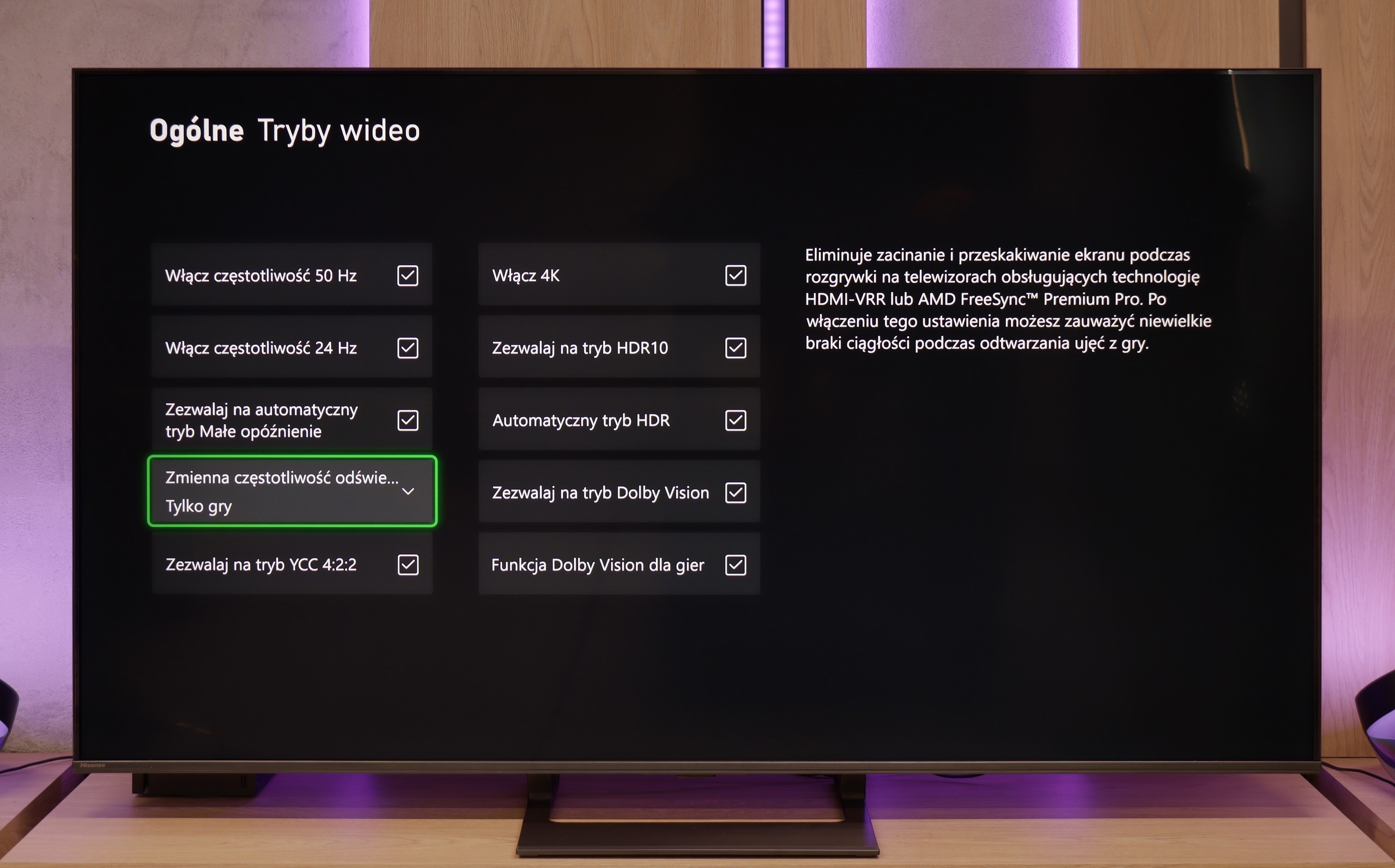

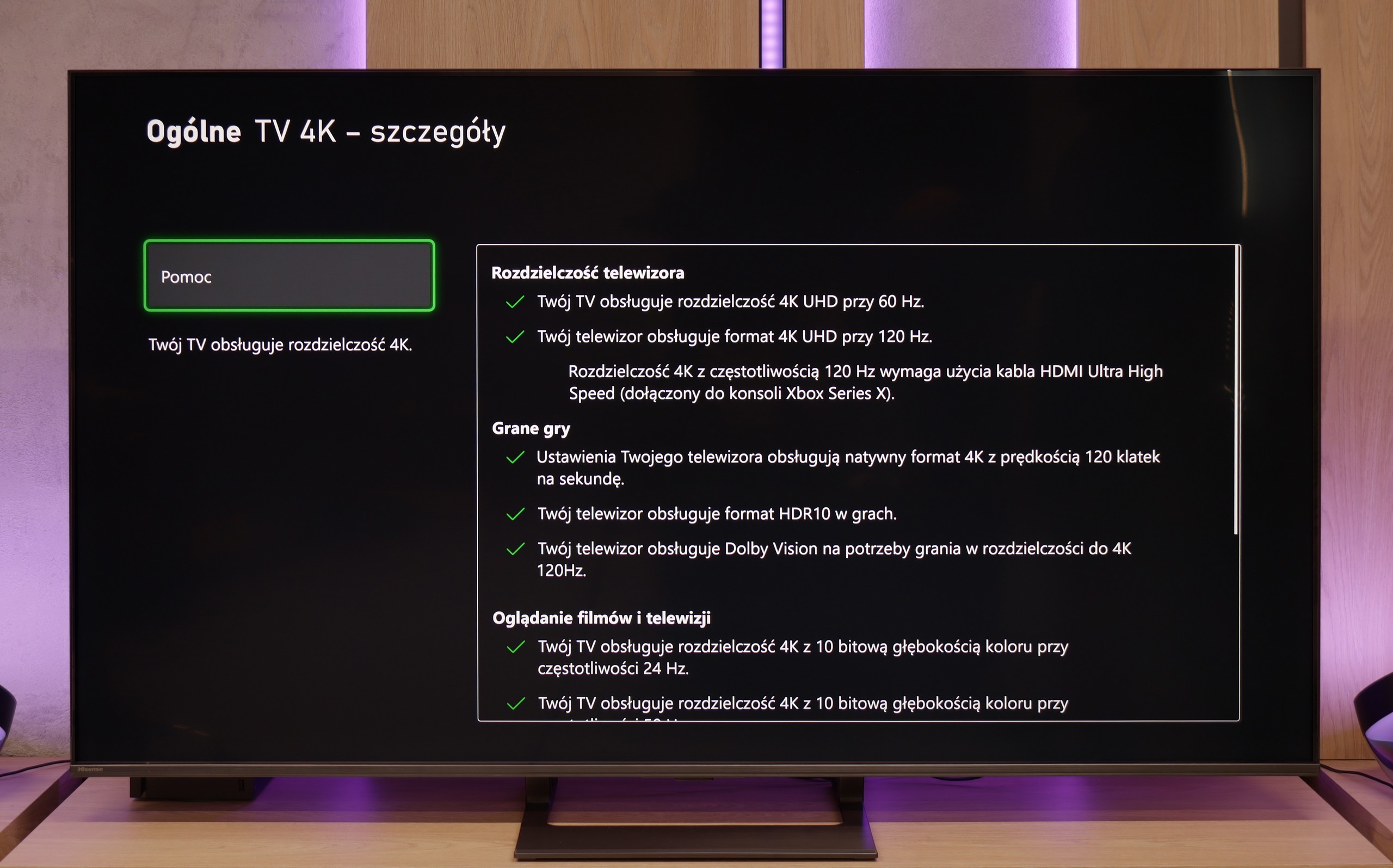

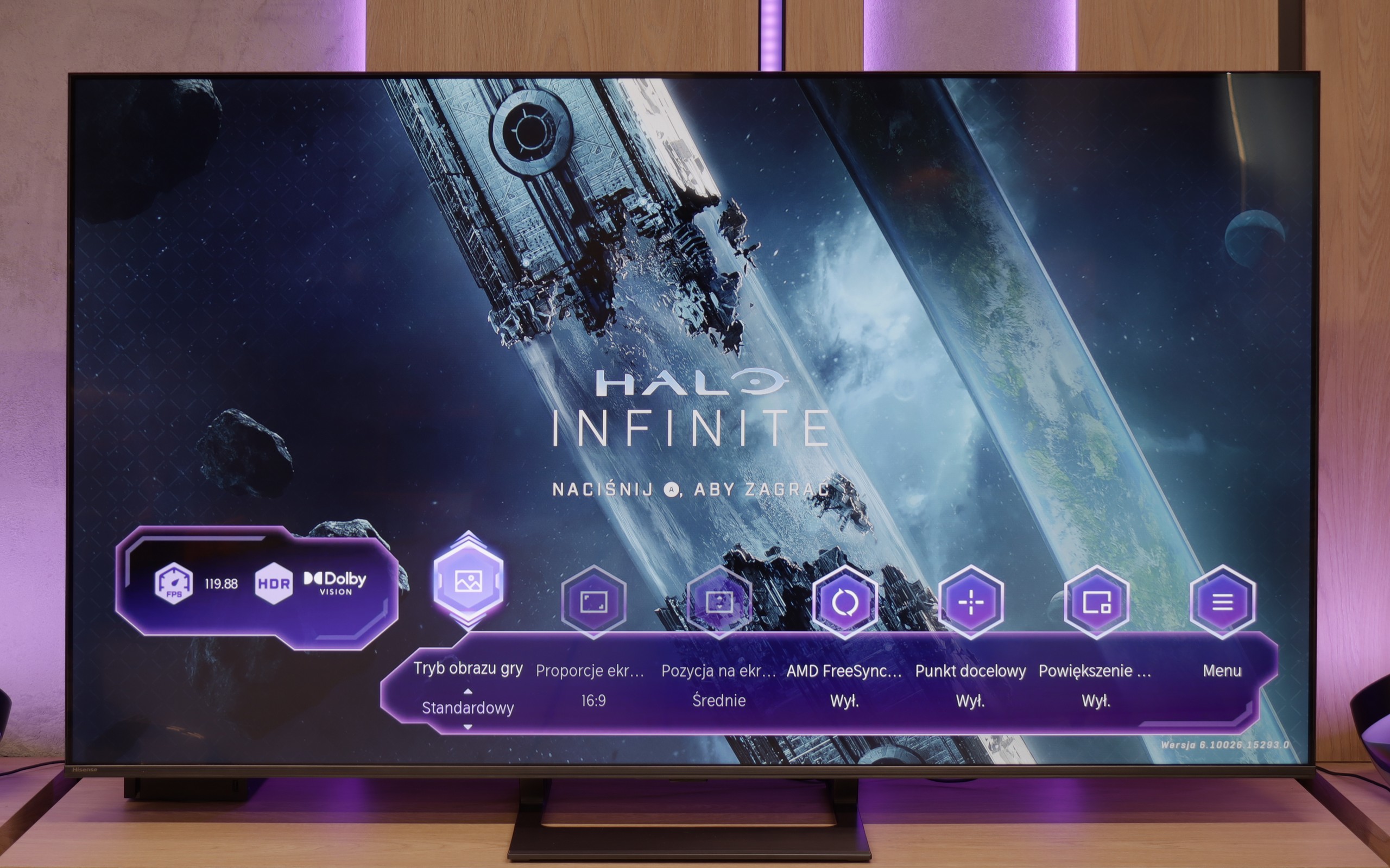

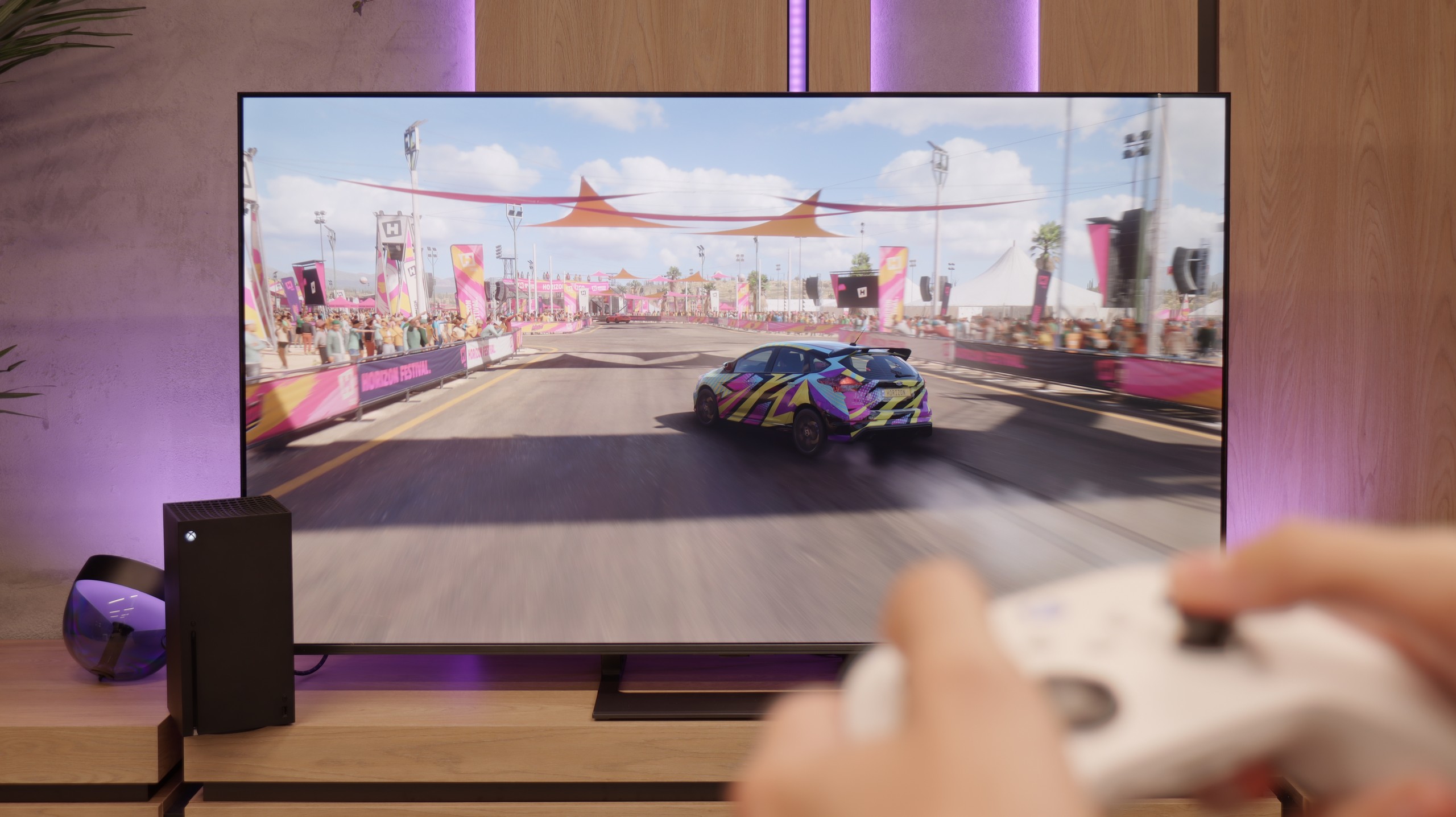

Hisense E8Q does not hide its gaming heritage. Even the specifications reveal that we are dealing with a television that will perform excellently as a gaming screen. Variable Refresh Rate (VRR)? It's there. Automatic switching to game mode (ALLM)? That's there too. Additionally, there is impressive refresh rate – 120 Hz in 4K or even 240 Hz in Full HD. Such a set is rare in this price segment. Everything works smoothly and without major surprises. The only missing element – similar to the U7Q – is support for HGiG. It’s a shame, as this feature facilitates adjusting the brightness curve to the capabilities of a specific television, improving visual compatibility with the intentions of HDR game creators. Without it, one has to manually fiddle with the settings, which does not always yield a satisfactory result.
Features for gamers in the Samsung Q7F is a topic that evokes quite a lot of mixed feelings. On the one hand – no sensible person expected miracles here, as it is after all a 60 Hz television and it was clear from the start that it would not be a device for squeezing the maximum out of a console or PC. On the other hand, since the manufacturer promised specific solutions in promotional materials, it is natural that we wanted to see them in practice. At the outset, it’s quite decent. The automatic game mode (ALLM) works, so there’s no need to manually fiddle with the settings; the console automatically switches the television to low-latency mode. Additionally, we have the Game Bar, which looks impressive and allows you to check a few basic parameters without leaving the game. And this is where the good news ends.
The biggest problem with the Q7F is VRR, or rather its absence. Yes, an appropriate icon appears in the menu, and you can even see it in the Game Bar, but throughout the entire test, the feature remained inactive and could not be enabled in any way. The situation with HGiG is even more painful; this option was indeed available at the beginning, but after a software update, it completely vanished, which is simply unprofessional. Therefore, the Q7F is only suited for the absolute basics. Of course, you can turn on the console, play some calmer titles, and enjoy low input lag, but if someone is counting on more advanced features that the manufacturer promised, they will be disappointed. This is not a television to buy with gaming in mind, and it's better to be aware of that before making a purchase.
Input lag
9.7/10
10/10
SDR
HDR
Dolby Vision
The E8Q handles delays very well. For 120 Hz materials, the input lag is super low – practically unnoticeable even for more demanding gamers. At 60 Hz, the values are slightly higher, but still comfortably within the "placebo" limit – there’s nothing to complain about. The biggest increase in delay was observed in Dolby Vision Gaming mode. The television then requires more time to process the signal, but even in this case, it doesn’t exceed 30 ms. While these may not be perfect values, for most gamers – especially console gamers – this will not be a hindrance.
Input lag on the Samsung Q7F is really good for a television with a 60 Hz panel. Measurements showed values below 12 ms, which means that for regular gaming on a console, this model is more than sufficient. Of course, it is not on the level of high-end 120 Hz screens, which can go as low as 6–7 ms, but in everyday practice, it is hard to talk about noticeable delay. In this respect, the Q7F does not fall behind its competitors in its segment and can easily be considered a safe choice for casual or sports gaming. At least in this regard.
Compatibility with PC
8.6/10
6/10
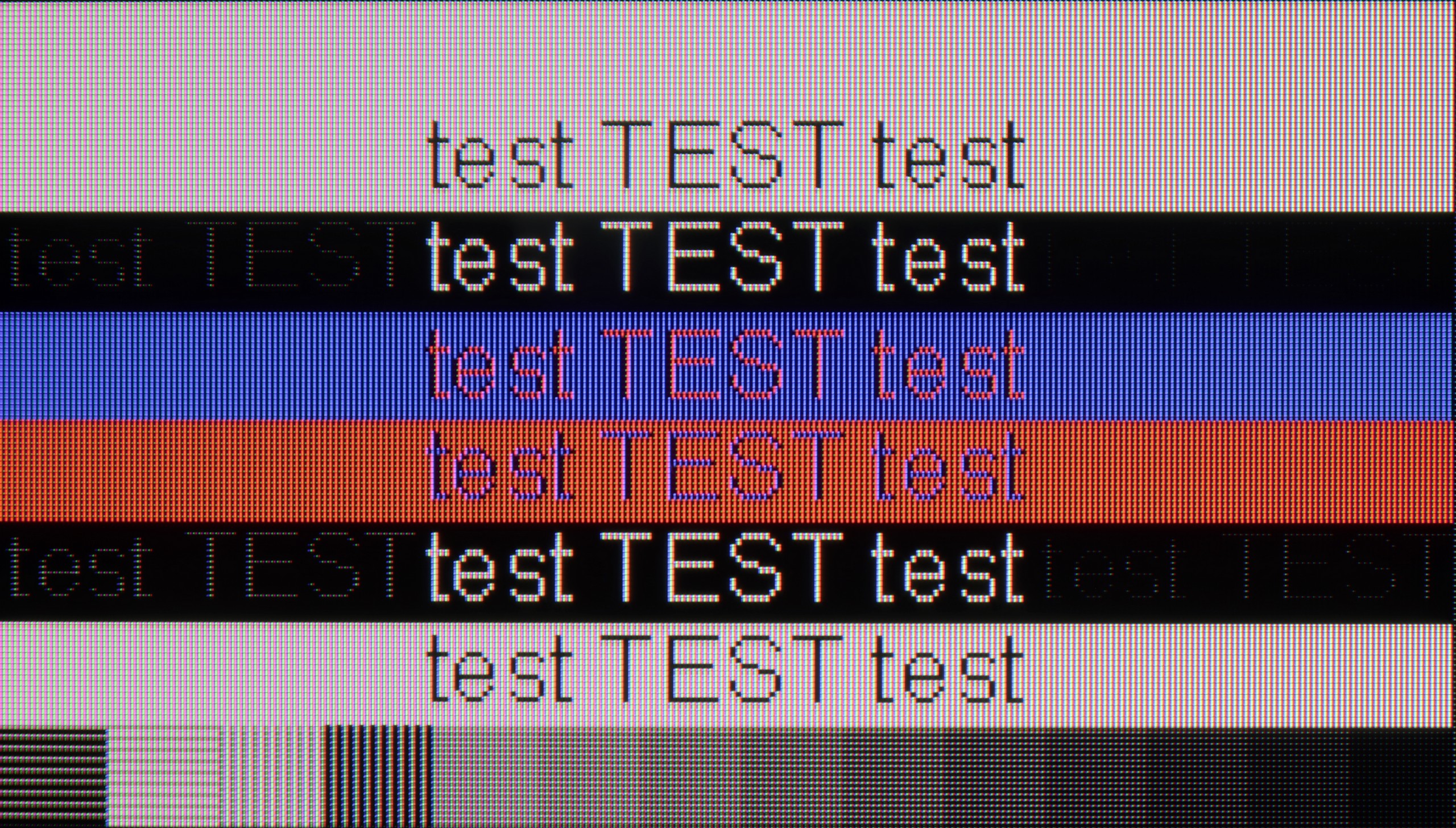

In terms of collaboration with the computer, the E8Q performs really well. It supports chroma 4:4:4 at full 4K resolution and at the highest refresh rate, so the readability of fonts – even the smallest ones – is at a very good level. There are some minor blurriness issues with exceptionally thin fonts, but in everyday use, this is hard to consider a serious problem. A nice addition for PC gamers is the ability to achieve up to 288 Hz at lower resolutions. The E8Q communicates effortlessly with powerful graphics cards, making it an interesting choice not only for movies or consoles but also for gaming on the computer.
Collaboration with a PC on the Q7F is decent, although it is not a television that will satisfy the most demanding users. Fonts are displayed clearly and sharply, so it is perfectly fine to work on it – especially for daily office tasks or browsing the internet. With thin letters, one can notice slight shadowing, but it is not something that interferes with normal use. In a smaller size, the Q7F can indeed work as a computer screen, although one must remember its limitations. The lack of variable refresh rate means we cannot use G-Sync or FreeSync, and 60 Hz practically closes the door to more demanding PC gaming. For work and light usage, it will be okay, but for serious gaming, it is definitely better to look for something higher in Samsung's offering.
Viewing angles
3/10
3.5/10
E8Q, like most TVs with a VA panel, looks best when we sit directly in front of the screen. In this position, one can expect deep blacks, good colour saturation, and high contrast. Unfortunately, it only takes a slight shift to the side for the image quality to diminish – colours begin to fade, and blacks become more grey than black. This is not surprising, but it is worth keeping in mind, especially if we plan to watch with a larger group from different spots in the living room. As a consolation – in return, we get significantly better black levels than in IPS panels.
The viewing angles on the Q7F are simply poor – typical for a VA panel. Just sitting slightly to the side immediately shows that the image loses quality. Colours fade, contrast clearly drops, and blacks start to resemble grey more than anything deep. This is a television that is definitely best viewed head-on, and any wider viewing angle comes with compromises.
TV efficiency during daytime
6.2/10
3.9/10
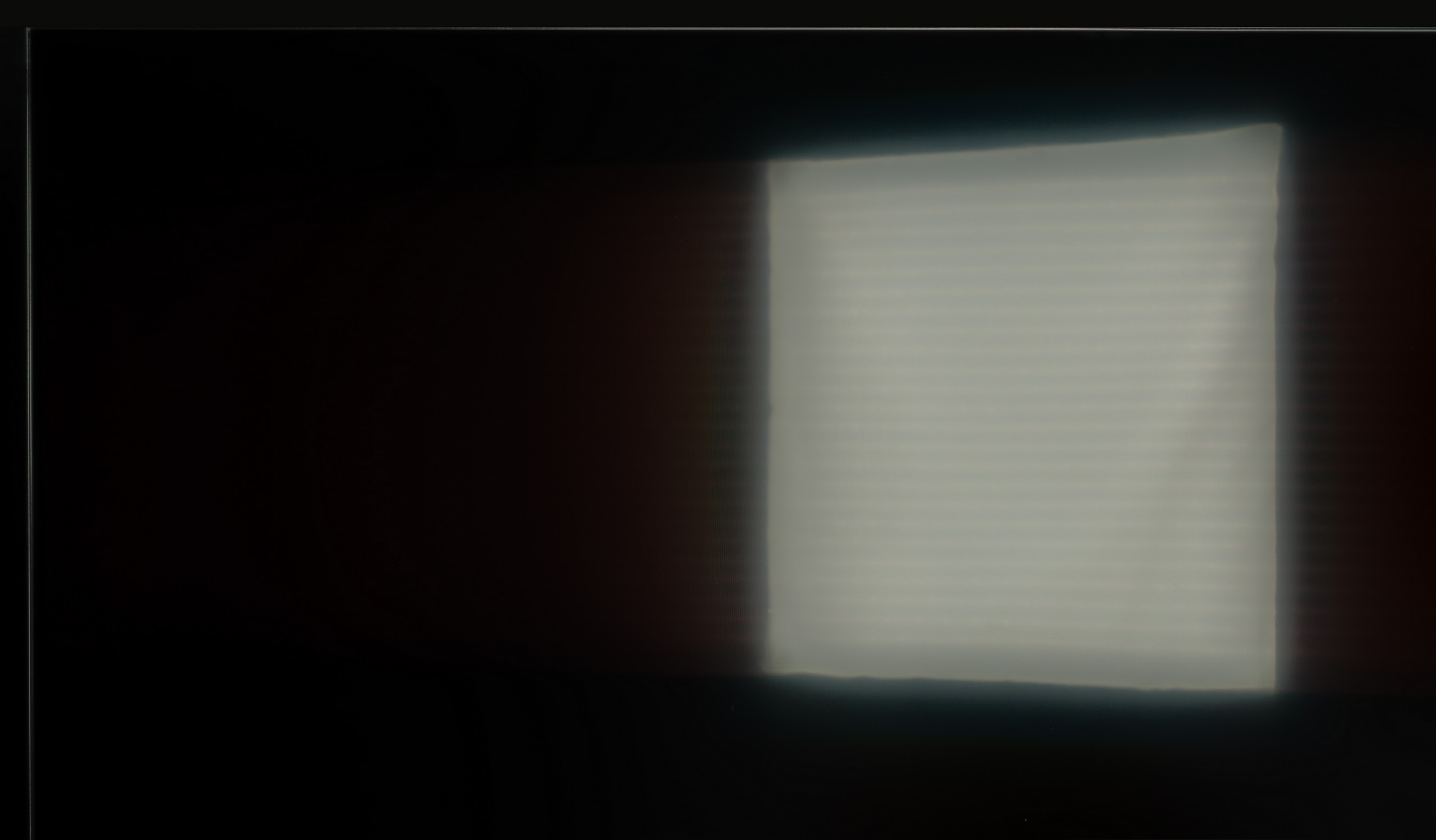



Matrix brightness
Average luminance SDR
Samsung Q7F: 237 cd/m2
Hisense E8Q: 504 cd/m2
Hisense E8Q is not afraid of bright interiors. Even if it is full sunlight outside, the television can maintain good image clarity. With a brightness level of around 500 nits, it is perfectly fine to watch content during the day without the feeling that everything is drowning in glare. The satin coating on the screen also helps to nicely suppress reflections – it does not eliminate them completely, but reduces them enough so they do not interfere with daily viewing.
The performance of the Q7F during the day unfortunately does not impress. Due to its low brightness, the screen quickly capitulates in very sunny rooms. It is therefore hard to recommend it to those who plan to watch television in a bright living room with large windows. In moderately lit rooms, it still performs adequately, but in bright light, the picture loses clarity. Additionally, the fact that the panel does not always effectively handle glare means reflections can be distracting during the day. This is more of a screen for evening viewing rather than for daily sessions in full sunlight.
Details about the matrix
Subpixel Structure:
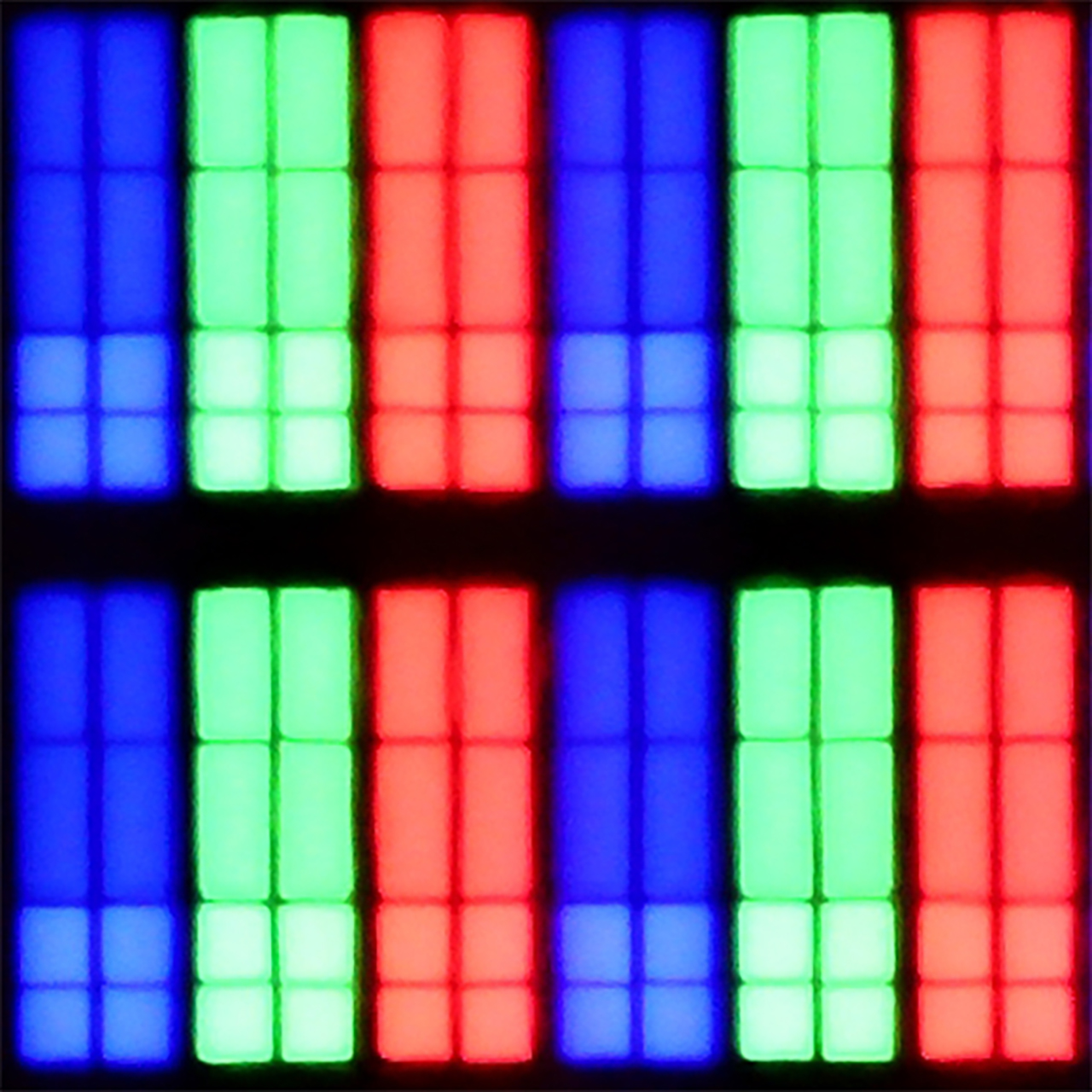

Panel uniformity and thermal imaging:
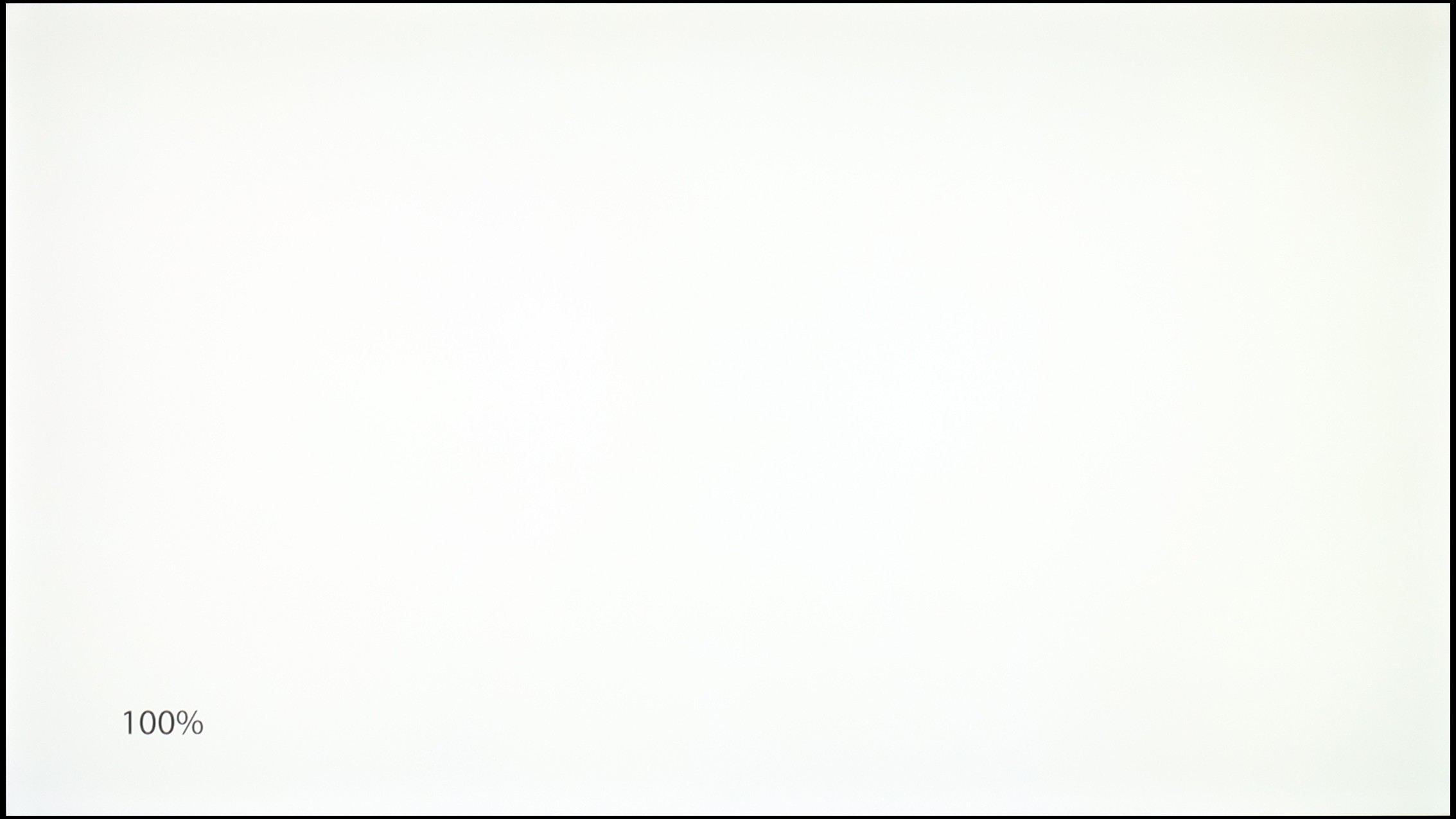

Hisense E8Q
Samsung Q7F
TV features
8.9/10
6.6/10
- HDMI inputs2 x HDMI 2.0, 2 x HDMI 2.1 48Gbps3 x HDMI 2.0, 0 x HDMI 2.1
- Other inputsRCA (Chinch)
- OutputsToslink (Optical audio), eARC (HDMI), ARC (HDMI), Mini-Jack (Headphones)Toslink (Optical audio), eARC (HDMI), ARC (HDMI)
- Network InterfacesWi-Fi 2.4GHz, Wi-Fi 5GHz, Ethernet (LAN) 100MbpsWi-Fi 2.4GHz, Wi-Fi 5GHz, Ethernet (LAN) 100Mbps
- TV receptionDVB-T, DVB-T2, DVB-S, DVB-S2, DVB-CDVB-T, DVB-T2, DVB-S, DVB-S2, DVB-C
Classic features:
- Recording to USB (terrestrial TV)
- Recording programming
- Picture in Picture (PiP)
- RF remote control (no need to aim at the screen)
- Backlit remote control
- Teletext
- Audio only mode
- Bluetooth headphones support
- Simultaneous Bluetooth headphones & TV audio
Smart features:
- AirPlay
- Screen mirroring (Windows Miracast)
- Voice search
- Voice search in native language
- Ability to connect a keyboard and mouse
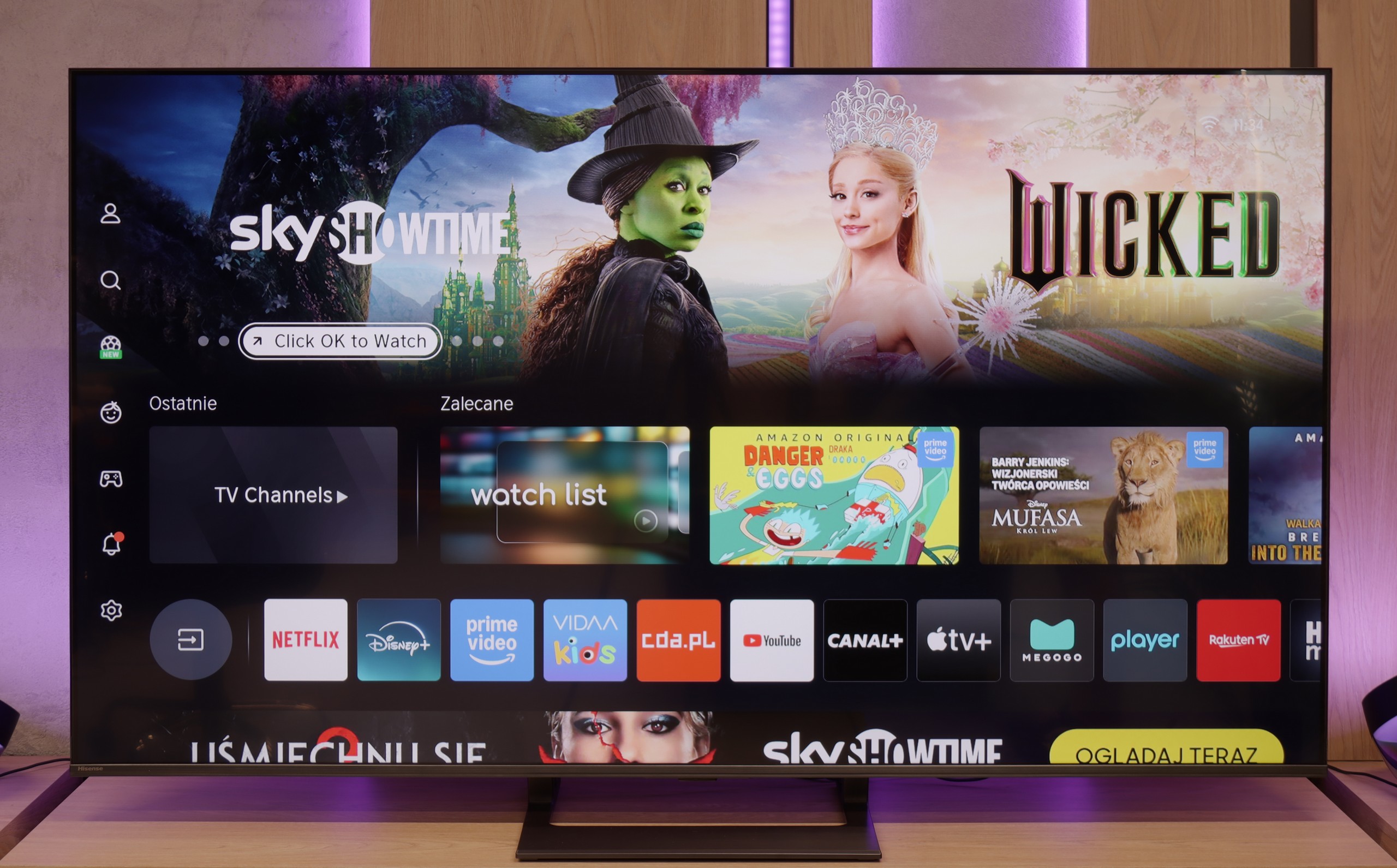
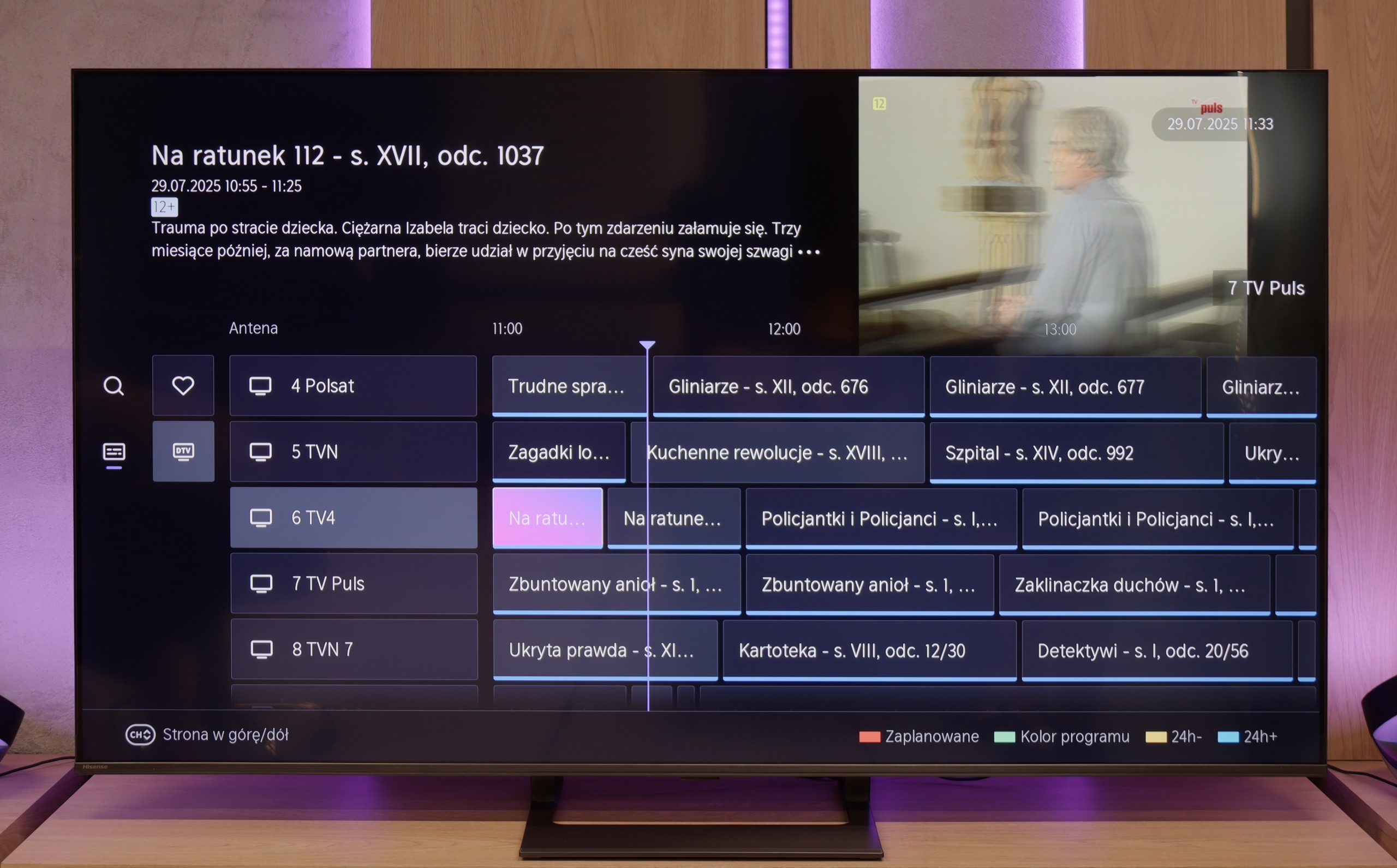
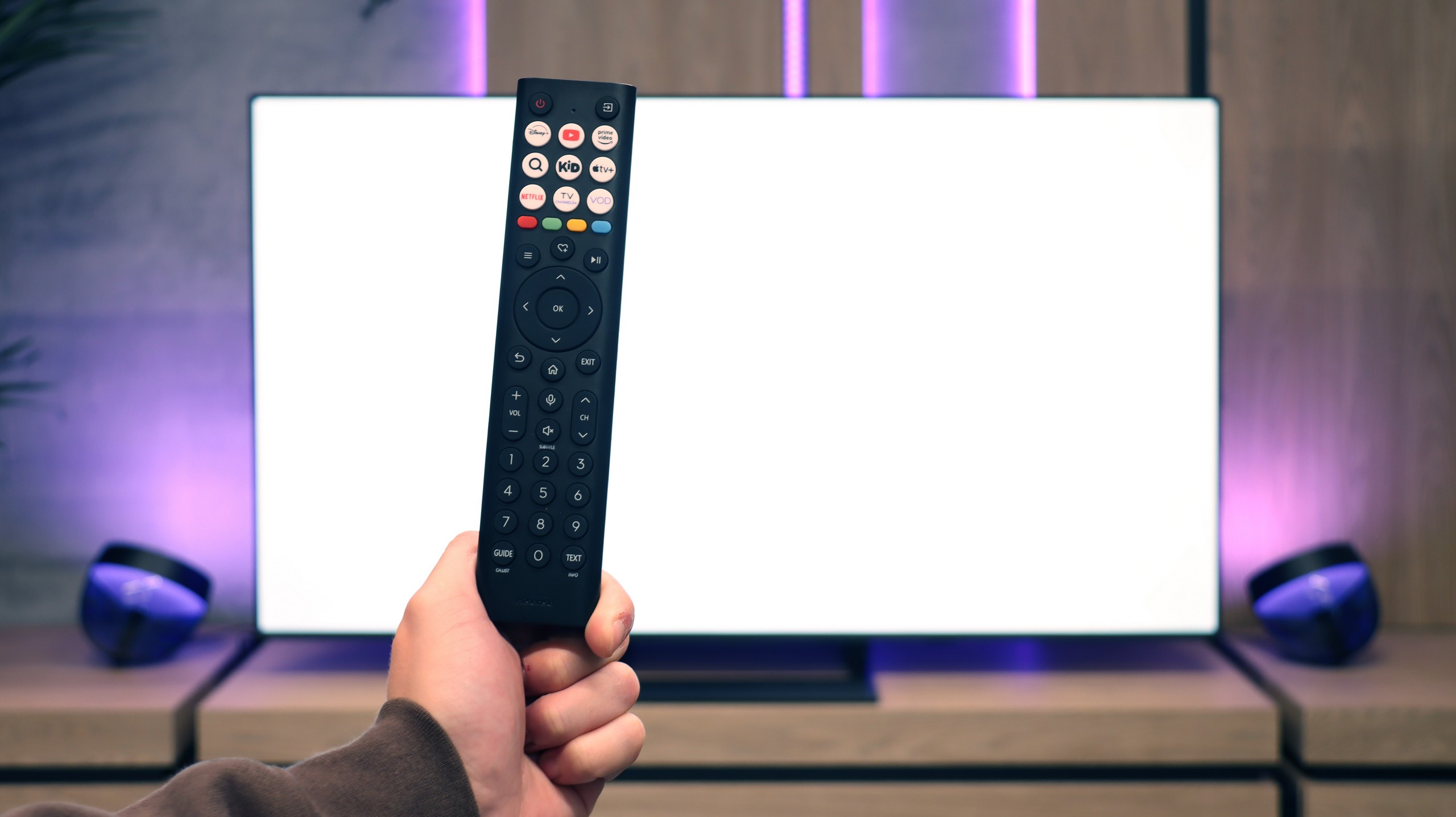





Classic Features – E8Q
The Hisense E8Q is not just equipment for gamers or movie enthusiasts – it can also serve as a daily television for the whole family. We can record programmes to USB, connect headphones or speakers via Bluetooth, and the entire interface – including the channel guide – is clear and easy to use. The only thing missing is the PiP function, but apart from that, the set of classic features is really comprehensive.
Smart TV – VIDAA System
The E8Q operates on the VIDAA system, which becomes more refined year after year. Voice search in Polish works flawlessly, and it's easy to stream content from your phone (AirPlay and screen mirroring). The system itself runs smoothly without hiccups, although – as is often the case with closed platforms – there may occasionally be one or two less popular apps missing. Therefore, it's worth checking before purchase whether everything we use on a daily basis is available there.
Smart TV – Tizen System
Here Q7F shows its strongest side. Samsung has been developing the Tizen system for years, and it is evident that we are dealing with a mature, well-refined platform. Everything runs smoothly, the menu does not lag even when switching between heavier applications, and installing additional programmes from the library is quick and hassle-free. In addition, there is full support for AirPlay, integration with voice assistants, as well as a wide range of add-ons – from cooperation with devices in the SmartThings ecosystem to the ability to control Philips Hue smart lighting or other smart gadgets. Samsung strongly focuses on advanced networking features, and this is evident – in terms of Smart TV, the Q7F has absolutely nothing to be ashamed of, and on the contrary, it can embarrass more expensive competitors.
Classic Features
On the side of classic, “television” solutions, it is clear that the manufacturer has bet everything on the smart card. We will not find any USB recording or PiP mode here, which used to be standard features. It is evident that the Q7F is meant to be primarily a multimedia centre, rather than a device for those accustomed to more traditional solutions. Fortunately, several practical additions are not lacking – we have Bluetooth for pairing headphones or speakers, and the option to change the font size in the menu, which will be appreciated by users with weaker eyesight.
Playing files from USB
8.2/10
9/10
Supported photo formats:
Maximum photo resolution:
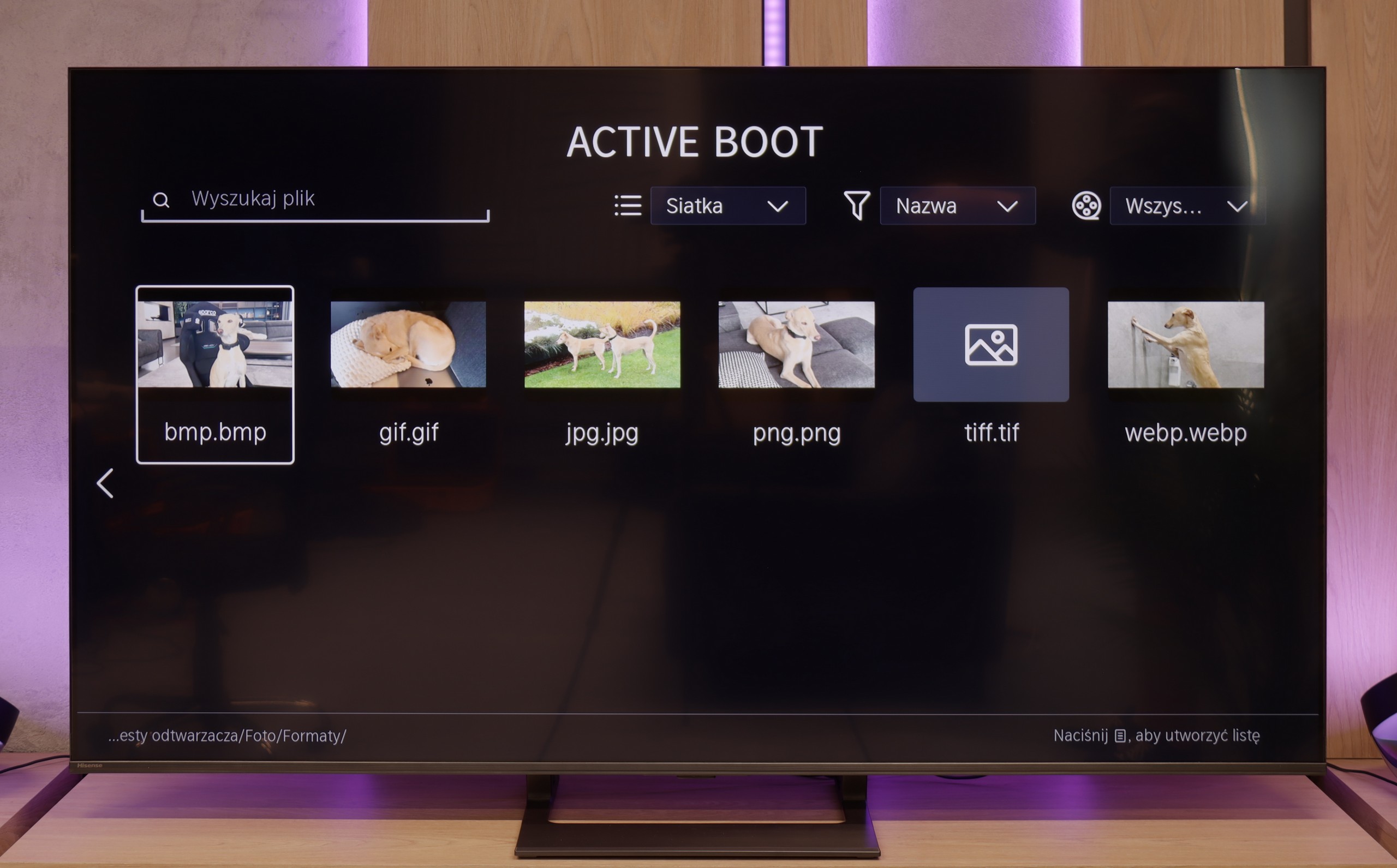

The built-in media player in the E8Q performs quite well. It supports most popular video and audio formats, and files from USB drives or external disks play without any major issues. Polish characters? They are supported. Subtitles? They work. The only minor drawback is the occasional problem with displaying high-resolution photos – especially those from cameras or smartphones. So, if you plan to show holiday photos on the big screen, it’s worth checking beforehand whether they all load correctly from disk memory or a USB drive.
In the Q7F we have a built-in file player, and as is usually the case with Samsung televisions, it works quite well – most popular films or music will play without fuss. For basic use, it is sufficient, and there is no real need to reach for external solutions like connecting a laptop. It is worse if someone wants to upload photos – here it can lag, especially with Apple's HEIC or PNG, which are visible in the player menu but do not necessarily want to work.
Apps
7.7/10
8.7/10














































Sound
7.2/10
5.8/10
- Maximum volume85dB80dB
- Dolby Digital Plus 7.1
- Dolby True HD 7.1
- Dolby Atmos in Dolby Digital Plus (JOC)
- Dolby Atmos in Dolby True HD
- DTS:X in DTS-HD MA
- DTS-HD Master Audio
Unfortunately, the Hisense E8Q did not make the best impression on us. Although on paper it has speakers with a power of 40 W (which is only slightly less than 50 W in the U7Q), in practice the difference is significant – and unfortunately not in favour of the E8Q. During testing, it quickly became apparent that something was amiss. When the volume was turned up above 40–50%, the entire back casing began to resonate, and unpleasant crackling sounds came from the TV. Even during regular viewing, it was hard not to notice this, and certainly – to not hear it. In this form, it is difficult to speak of listening comfort. We do not rule out that this was an issue with a specific test unit, but nonetheless – it is worth keeping this in mind. If you care about good sound, consider connecting a soundbar or… just go for the U7Q, which performs significantly better.
The Samsung Q7F comes with a 20 W speaker system and… well, let’s not kid ourselves, it’s nothing revolutionary. The television itself sounds quite decent, meaning we can clearly hear series, news, or daily programmes; dialogues do not get lost, but there’s a significant lack of depth and sound space. There is virtually no bass; it thuds somewhat, but it resembles more of a box being tapped rather than true low tones. Music comes across flat, and films don't make any significant impression – we won’t feel like we're in a cinema. It’s sound from the ‘acceptable’ category, just enough to have something built-in, but if someone is counting on a stronger experience, they will inevitably reach for a soundbar sooner or later. And to be honest – even the simplest model will make a considerable difference, and Samsung has quite a few in their offering.
Acoustic Measurements
85dBC (Max)
75dBC
80dBC (Max)
75dBC


